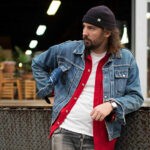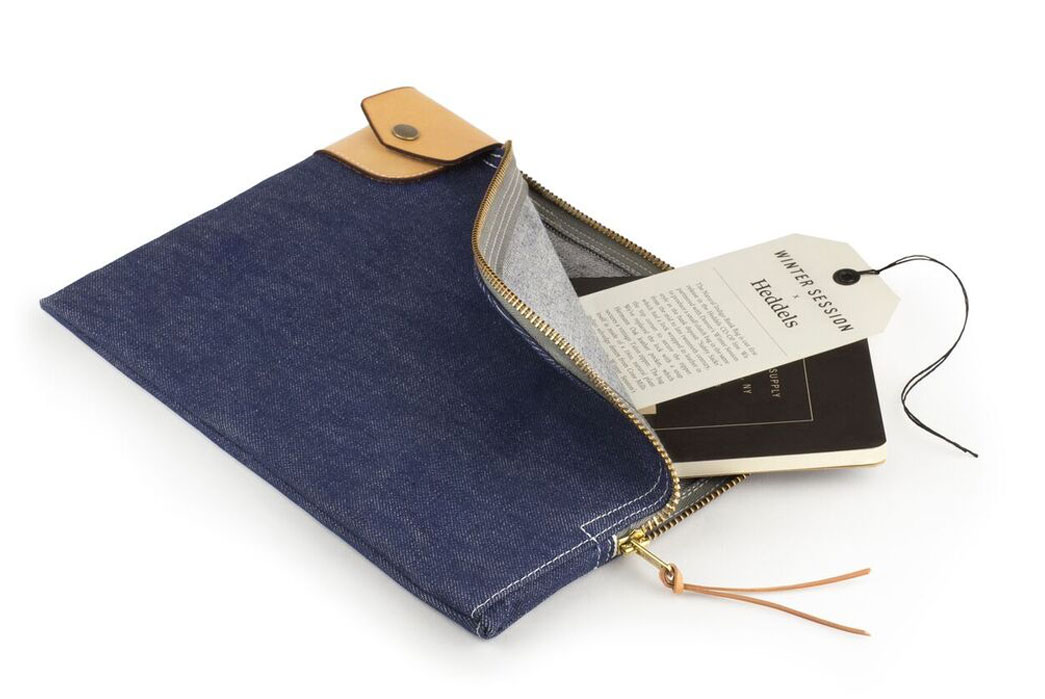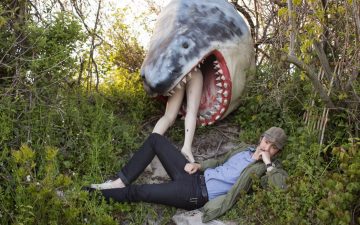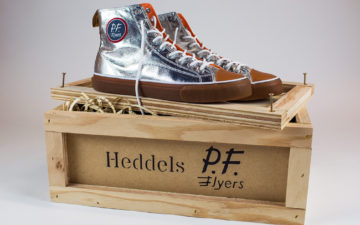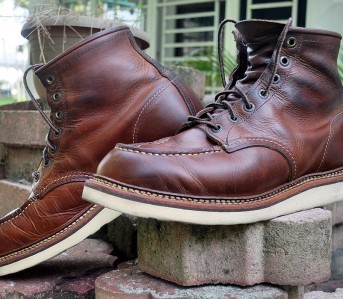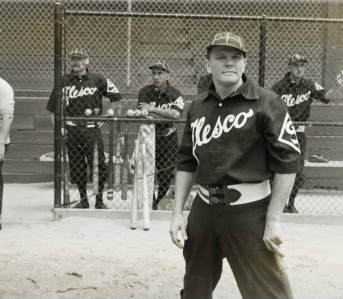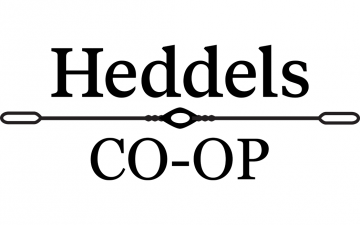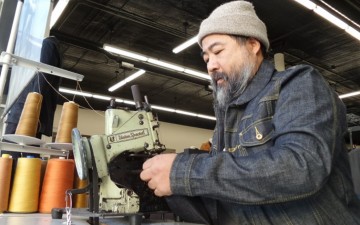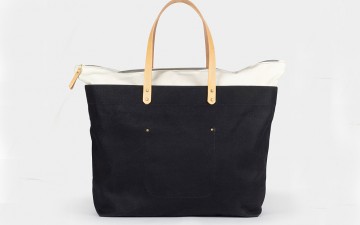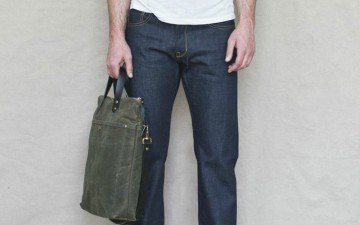This is the first iteration of our CO-OP series, our collaborations with brands we admire to create limited runs of specialized products exclusively for Heddels readers. By working with the brand, we hope to dive far deeper into who they are and how they operate than we ever could have with a profile. We have an extensive list of rules that we have to abide by for each product to bear the CO-OP label.
Our CO-OP articles serve as the complete documentation of how we created our product, from concept to sales. This article covers the creation process with Denver brand Winter Session on our first product, the Natural Indigo Bank Bag.
Why Winter Session
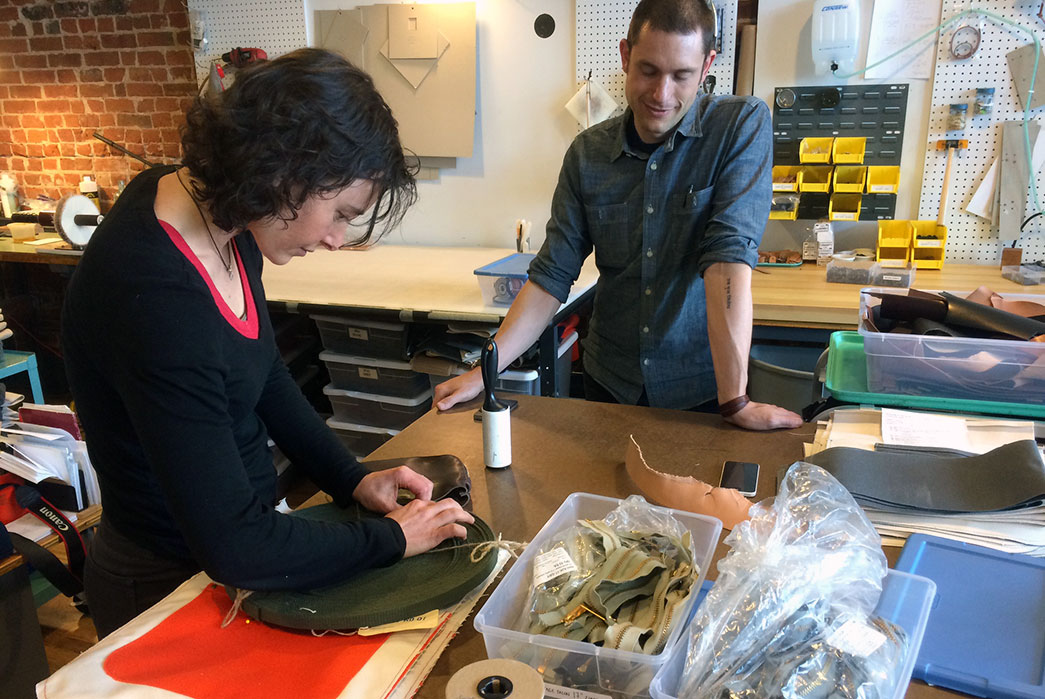
Owners Tanya Fleisher and Roy Katz.
When I first began dreaming up the possibility of collaborative products with what at the time was Rawr Denim, I knew I wanted the first one to be with Winter Session.
Winter Session began as an experiment in Roy Katz and Tanya Fleisher’s Chicago apartment in 2010. Roy was a freelance architect and wanted to work on more hands on projects, Tanya was just finishing her MFA. A couple sewing machines later, the brand was born.
After a few years of slowly growing from friend orders, to local accounts, to a few international doors and a couple employees, Roy and Tanya were ready to return home to Denver. They moved into a small workshop in Denver’s Five Points neighborhood.
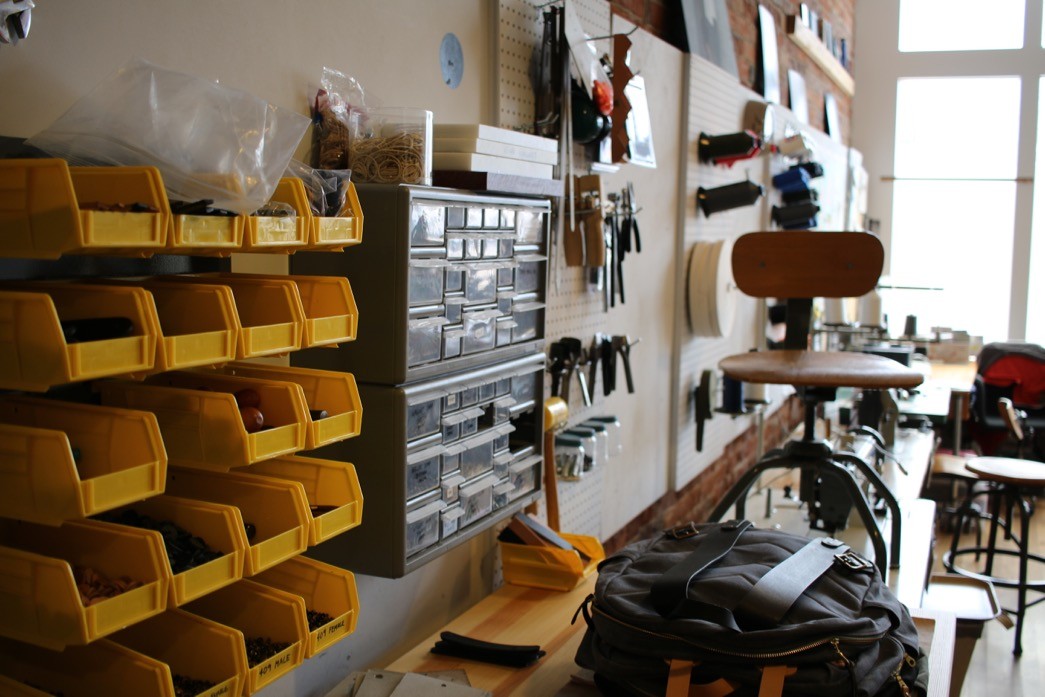
I’ve known Roy Katz and Tanya Fleisher since early 2014, when I published my rundown of stores in Denver and Roy emailed me to explain that I had gotten Tanya’s name wrong in my write up. I would soon move back to Denver (I grew up in the suburbs) and become a frequent fixture in the store.
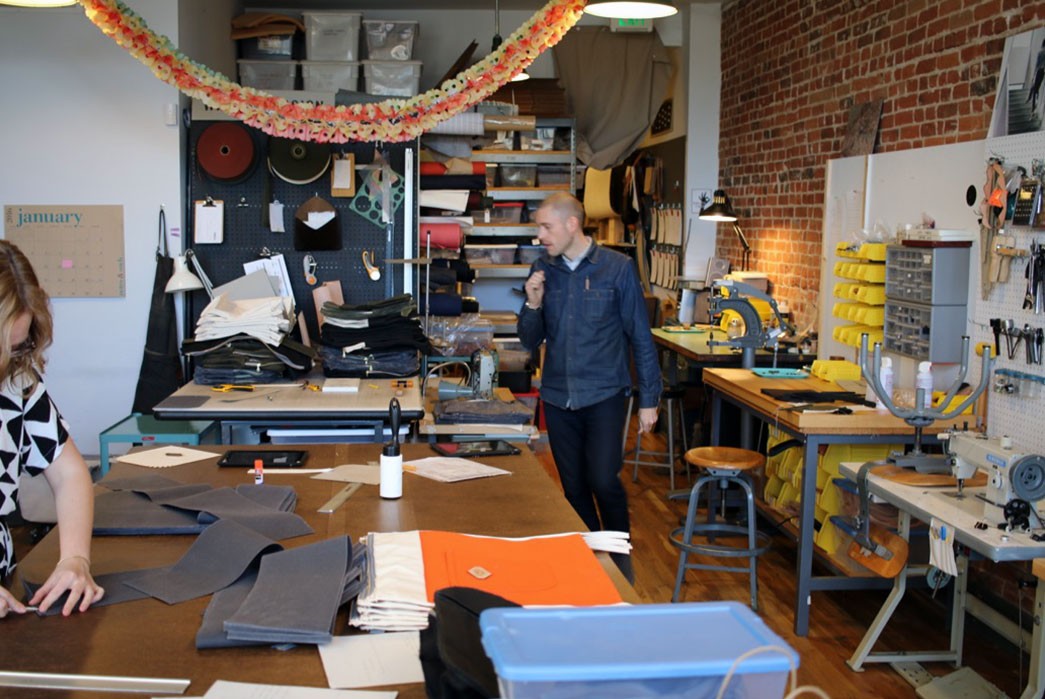
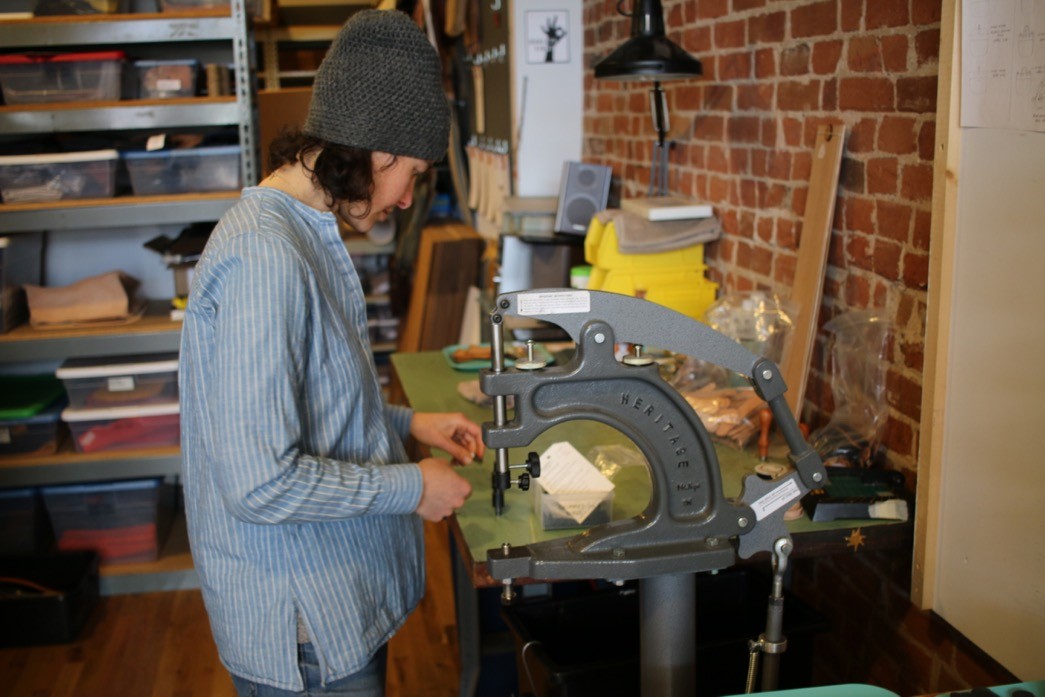
I was teaching myself how to sew, and I was determined to make a zip bag like theirs. But as much as I had experienced and studied things that had been sewn for years, the origami folding, seam allowance, and spatial reasoning of even the simplest item they made was beyond my scope.
I would pop in at least twice a week, each time with a slightly less mangled zip pouch and ask, “What did I get wrong this time?” A few folds and an explanation later, I was back out the door towards my next sewing pitfall and another trip back for advice.
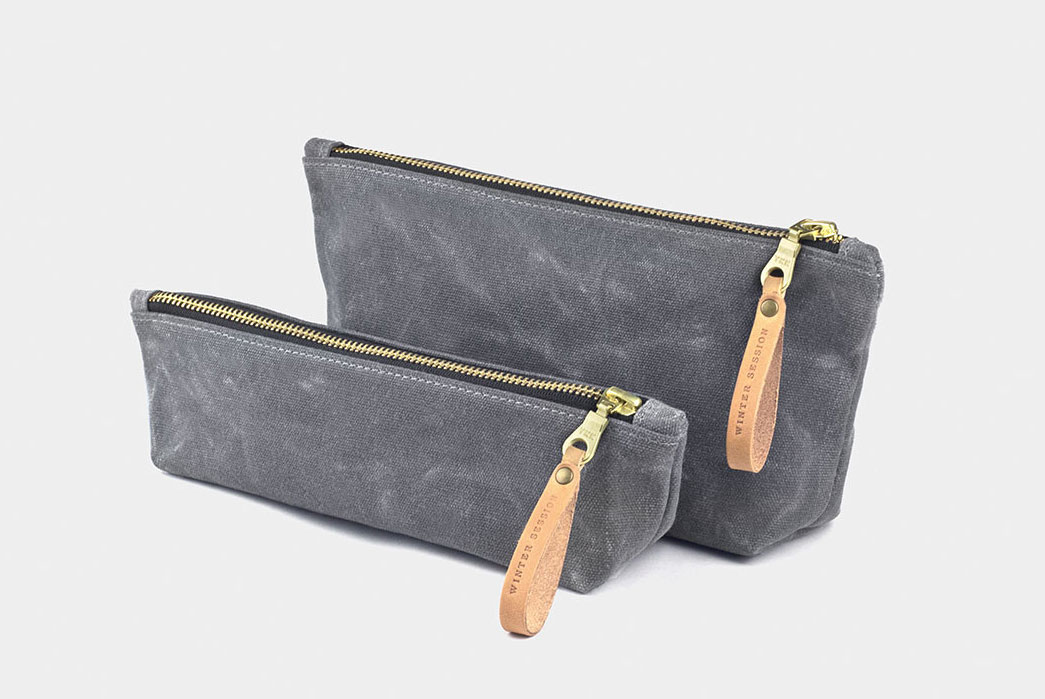
Winter Session’s zip bag, my white whale.
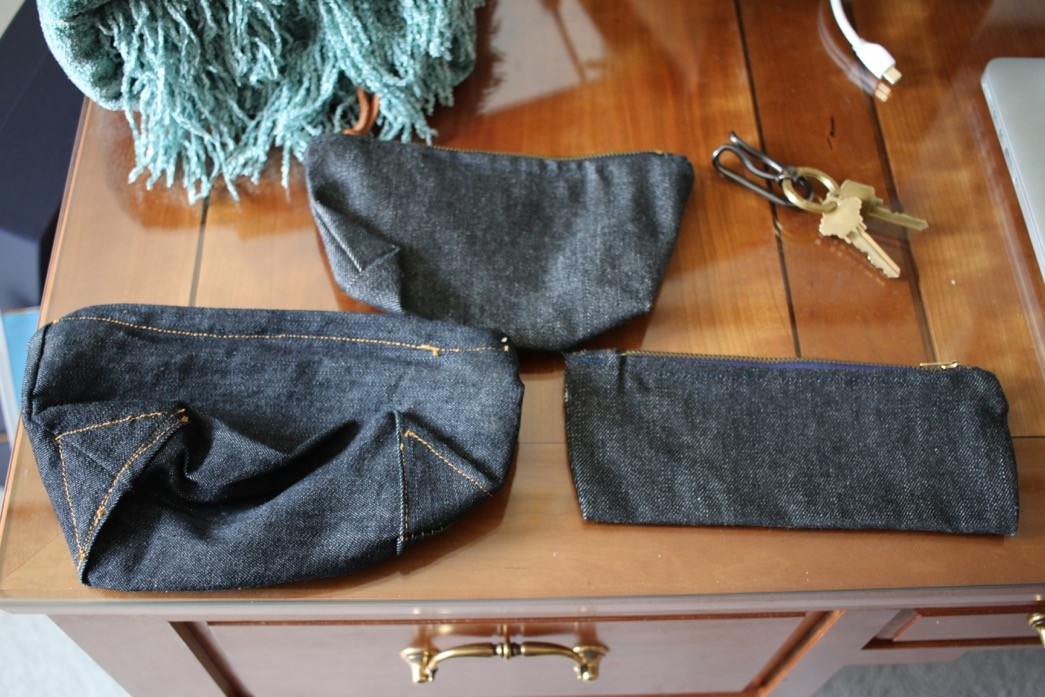
My first three (tragic) attempts at a zip bag.
After about 10 bags, I was getting pretty decent at it. I had graduated beyond my local Joann Fabrics and Winter Session and I began exchanging sewing supplies for chocolate. Zippers, fabric, thread, cotton tape; whatever they had left over, I was swapping for pecan clusters and Caramelo bars every couple of weeks.
Roy and Tanya aren’t just designers, they’re craftspeople that produce all of their products in house with their small team of sewers. They keep some of the old artisanal methods alive, like hand saddle-stitching their leather goods, but also incorporate new technology, like laser cutting. It’s all about producing the best possible product by the most efficient means.
As such, their products are sleek, comfortable, and human. Every Winter Session piece is conceived, sourced, and created by Winter Session so designs evolve iteratively and immediately, with tiny improvements on almost every run that would be much more difficult with contracted sewing.
The Idea
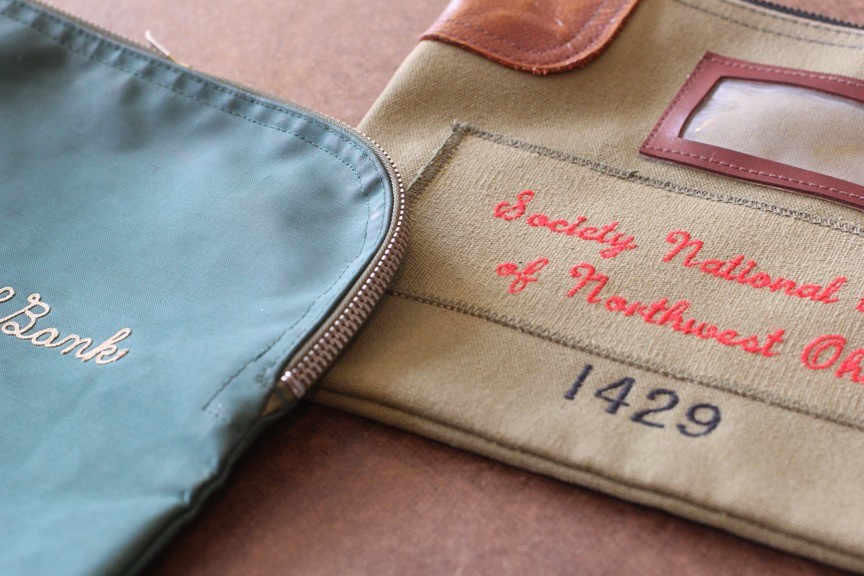
I first began talking to Roy and Tanya about a collaboration over a year ago, in January of 2015. I wanted to make a zip bag in denim with a few of the modifications I’d created: selvedge details at the end of the zips, gold jeans stitching, and a lace leather zip pull.
That’s when they told me they’d been sitting on about a hundred vintage cotton-taped Talon zippers for about two years. Now these aren’t the Japanese repros we’re talking about, but the real deal, mid-century, American made zippers–the holy grail of hardware finds. The zippers, however, were a lengthy fifteen and seventeen inches and using them on a zip pouch would mean cutting them down.
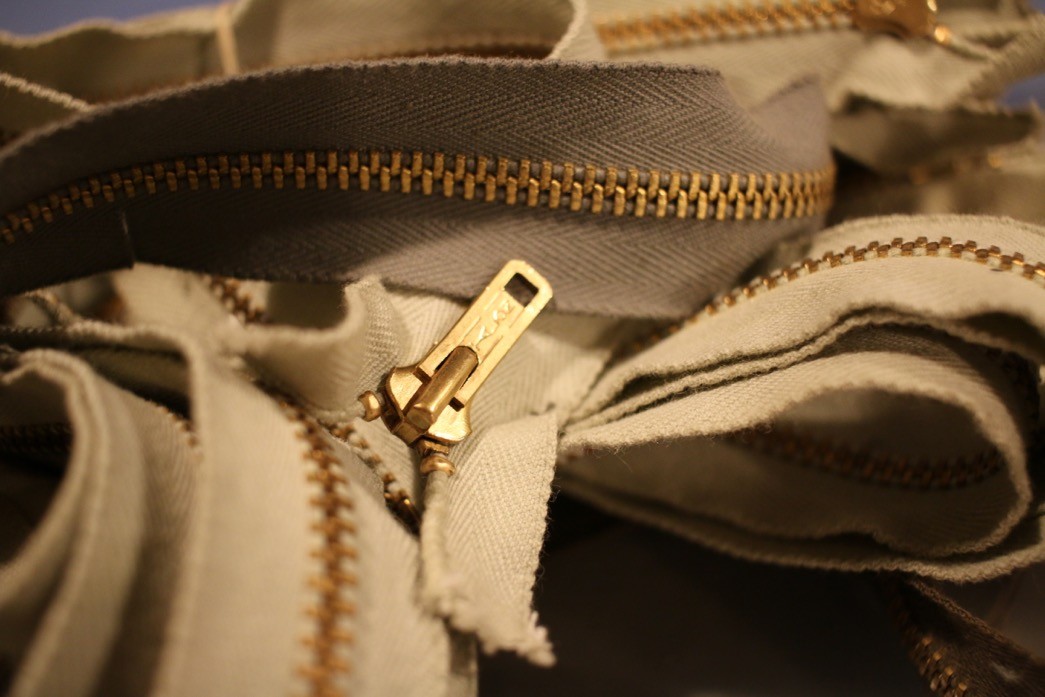
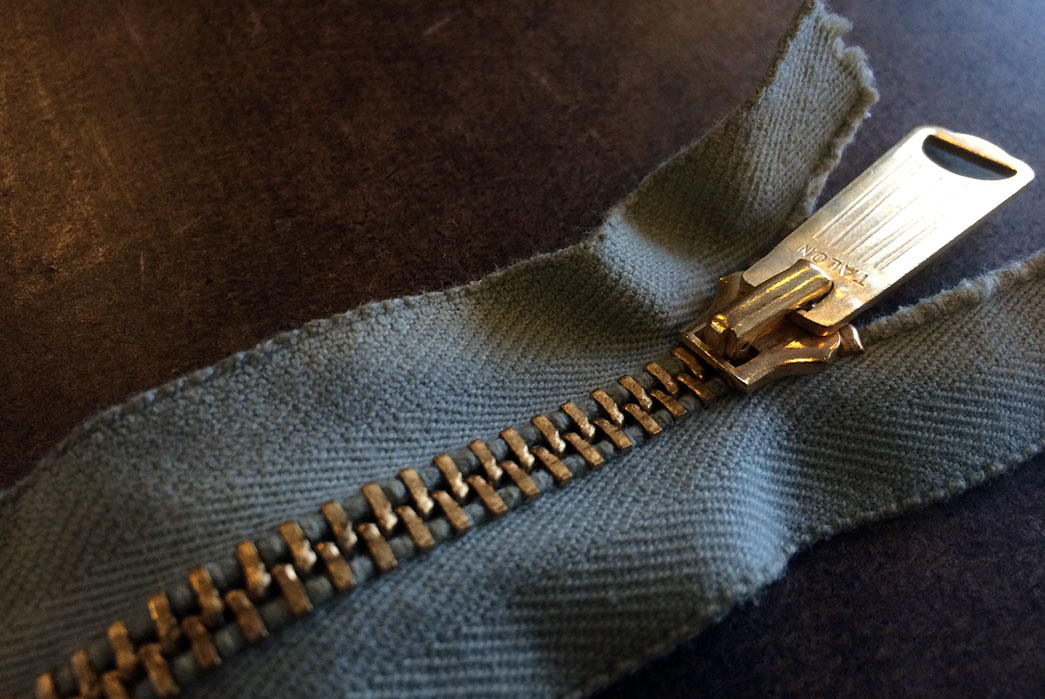
So we began thinking of ways we could make something like a zip bag but still use the entire length of the zipper. Our contributor, Laura Staugaitis (who worked at Winter Session at the time), suggested the humble Bank Bag.
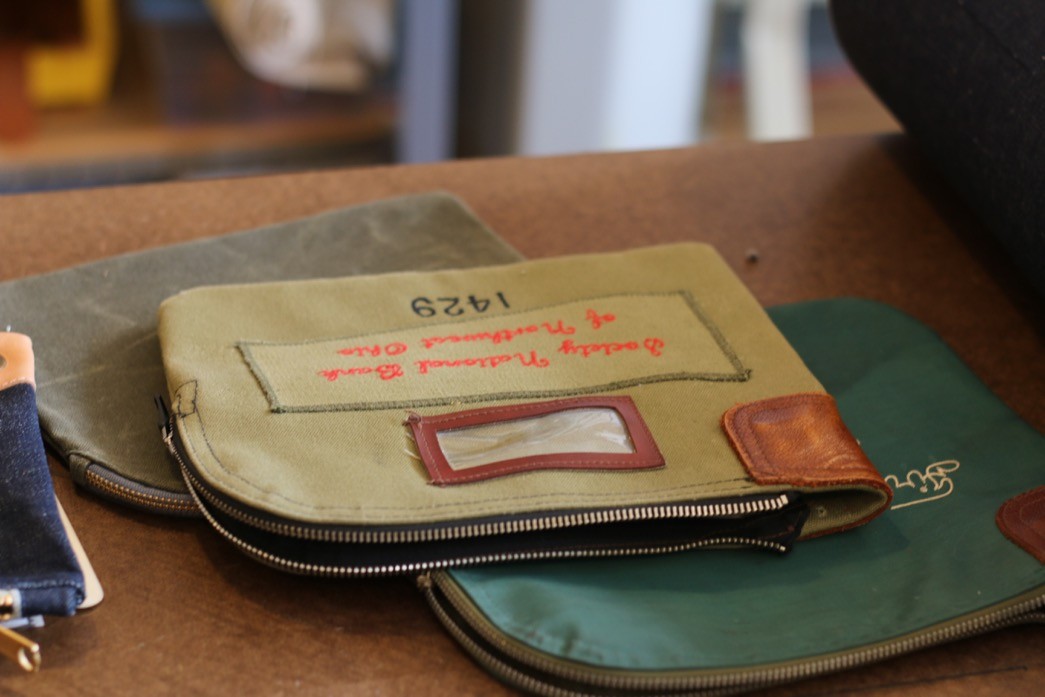
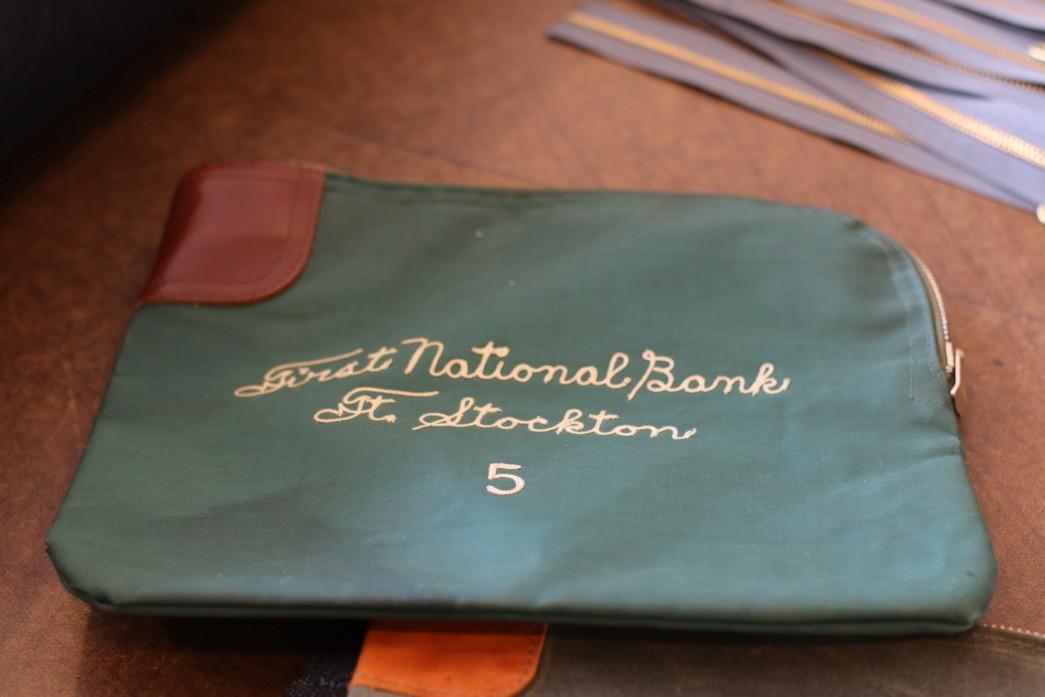
If you’ve ever worked retail, you know what I’m talking about: a rectangular canvas pouch with a rounded zipper that sets into a chrome lock.
These bags were the standard for almost all retail businesses to move their cash and checks from the store to the bank. The goal wasn’t to keep people from running off with the money, but just make sure it wasn’t tampered with and kept everyone honest.
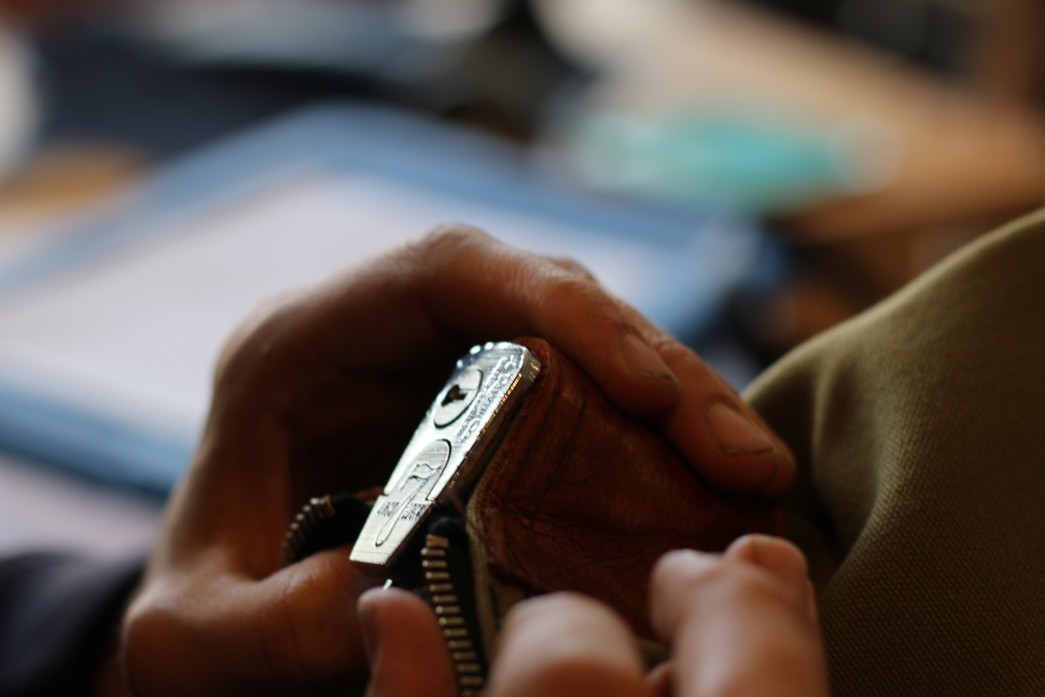
The canonical example of a bank bag is the Rifkin Safety Sac, which has been made in Pennsylvanial by the Rifkin company since 1892.
We had the zippers, an original bag in transit from eBay, and a general idea of what we wanted. But this was also the first time I had ever created a product, and there was a long road ahead of us to get from that idea to a bag in our hands.
Sourcing
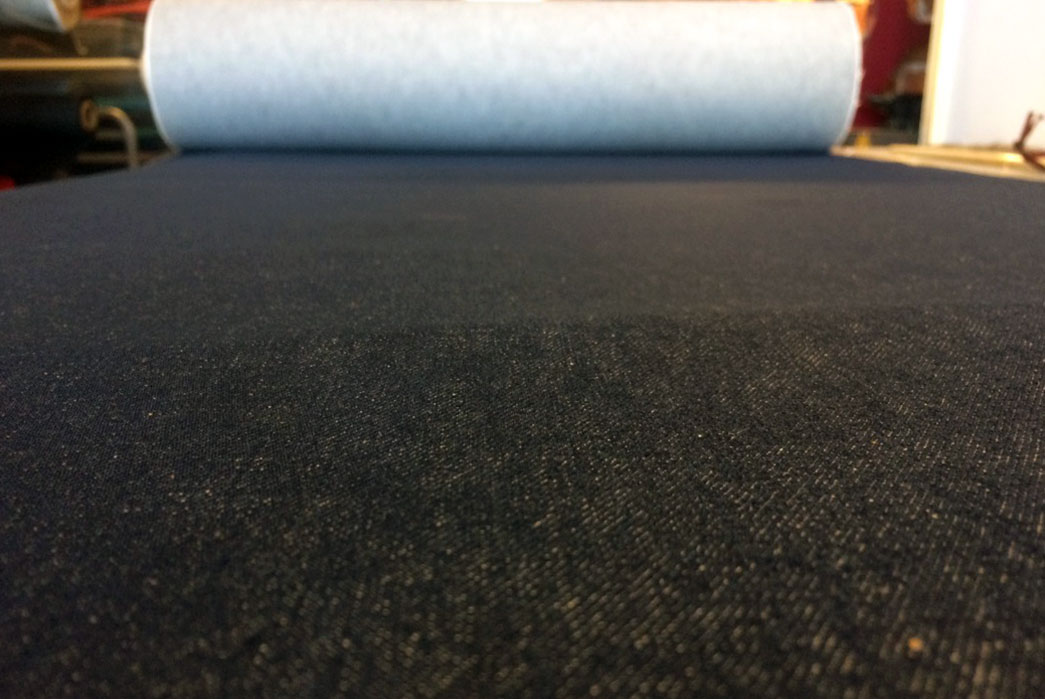
You’ve gotta crawl before you can walk, and you’ve gotta source before you can sew. We knew that the bag should be made of denim, obviously, but which one? For a bag, it had to be something relatively substantial. We experimented with a few samples, but nothing less than 15oz. seemed to do the trick.
You may have noticed that we occasionally go to fabric trade shows, like Kingpins and Denim by PV. Our coverage of those shows may not be the biggest crowd-pleaser, but it’s allowed us to see the cutting edge of the fabric scene and what the best mills in the world are producing every season.
Last July, Gerald and I were at the Kingpins show in New York, where we first encountered a new denim from Cone Mills–Natural Indigo Selvedge Denim from their White Oak Plant. Cone’s VP of Product Development, Kara Nicholas, explained that for the first time in a hundred years, Cone was partnering with American farmers to produce a denim made from natural plant indigo grown, fermented, and dyed in the United States.
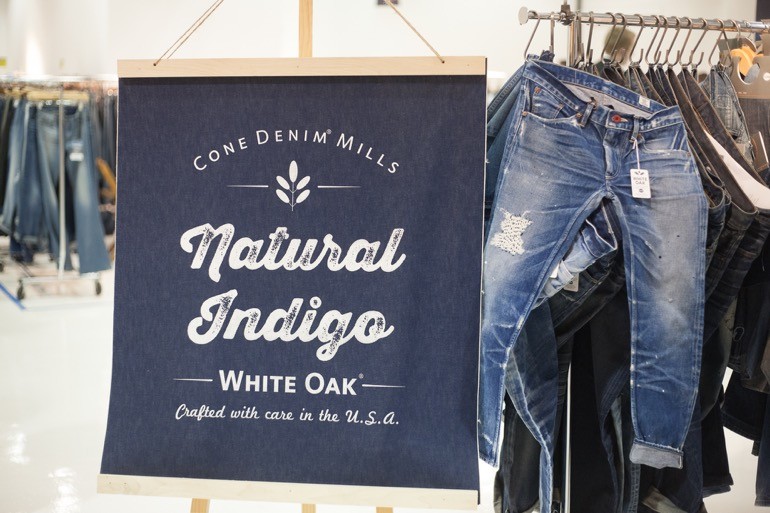
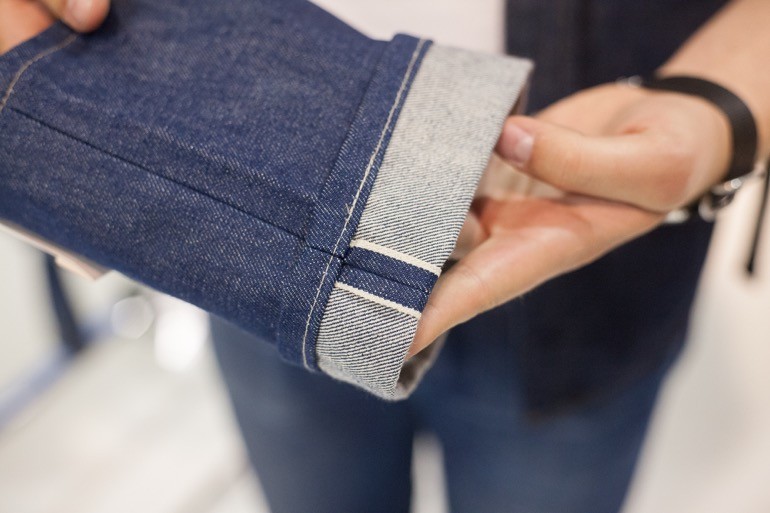
The denim itself is a bright vibrant blue with a white selvedge id, making even Cone’s 1968 denim look dull by comparison.
They were doing two weights, 13.25oz. and 16oz. I told Kara we had to have the heavier 16oz. for our bag and after a quick P.O., we had 30 yards of the very first dye lot at Winter Session.
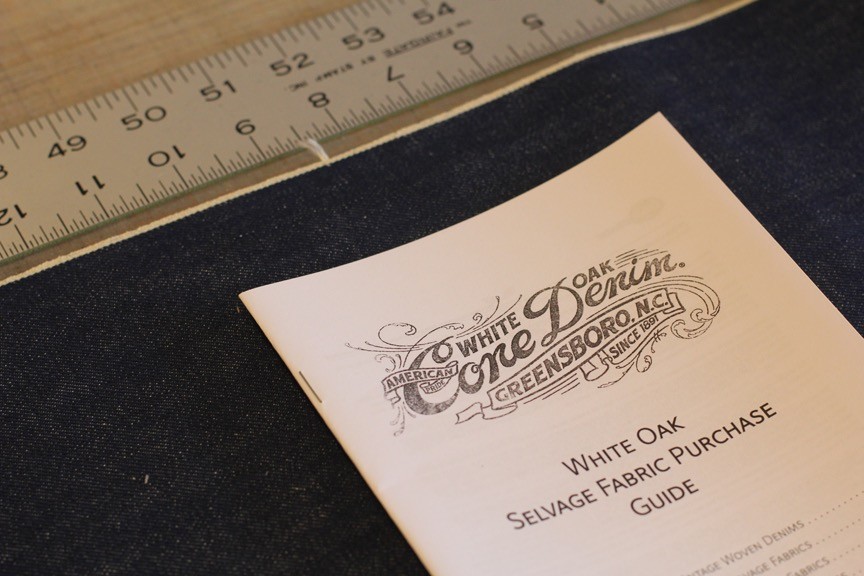
Cone Denim apparently comes with an owner’s manual.
For leather, we went with Winter Session’s standard 4oz. natural veg-tan from the Hermann Oak tannery in St. Louis. It starts out super light in color, but quickly patinas with use.
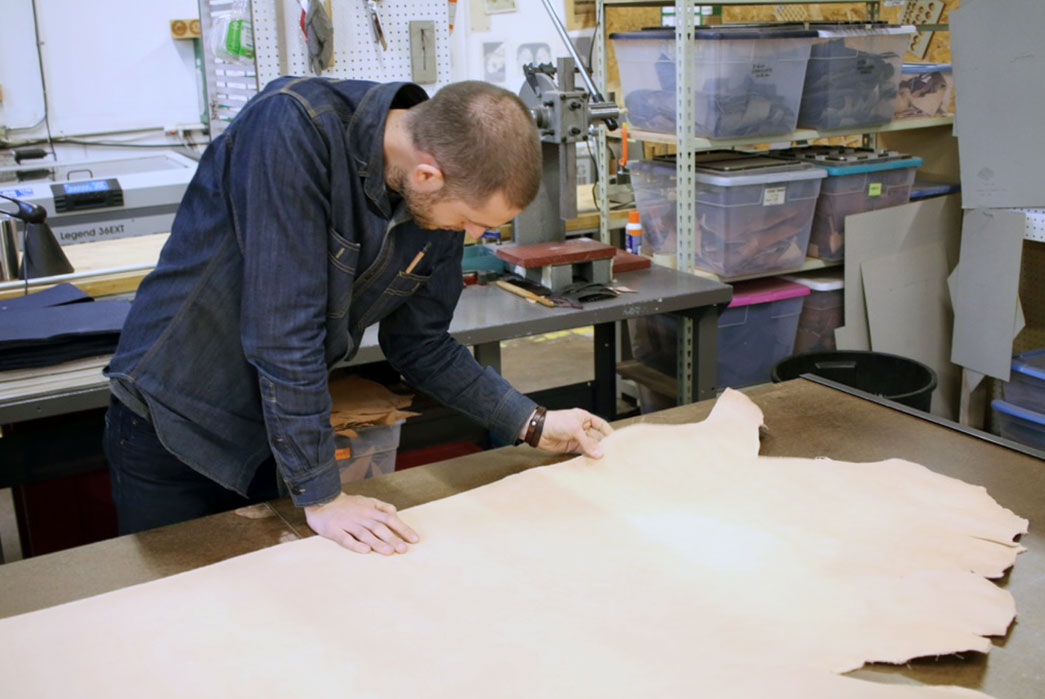
For thread, we went with a #69 natural-colored nylon thread from American and Efird (second from the left, below) that Winter Session uses as a standard on all of their heavier duty fabrics. If it holds up with their 22oz. waxed canvas, a denim zip bag like ours should be no problem.
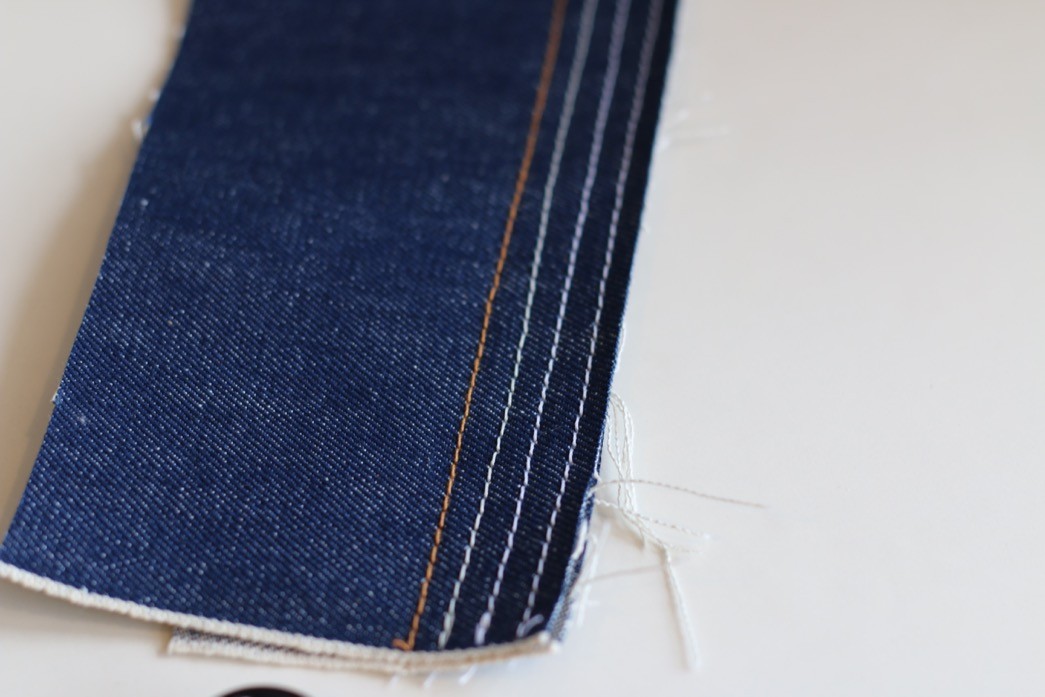
We had our materials, now what to do with them?
Designing
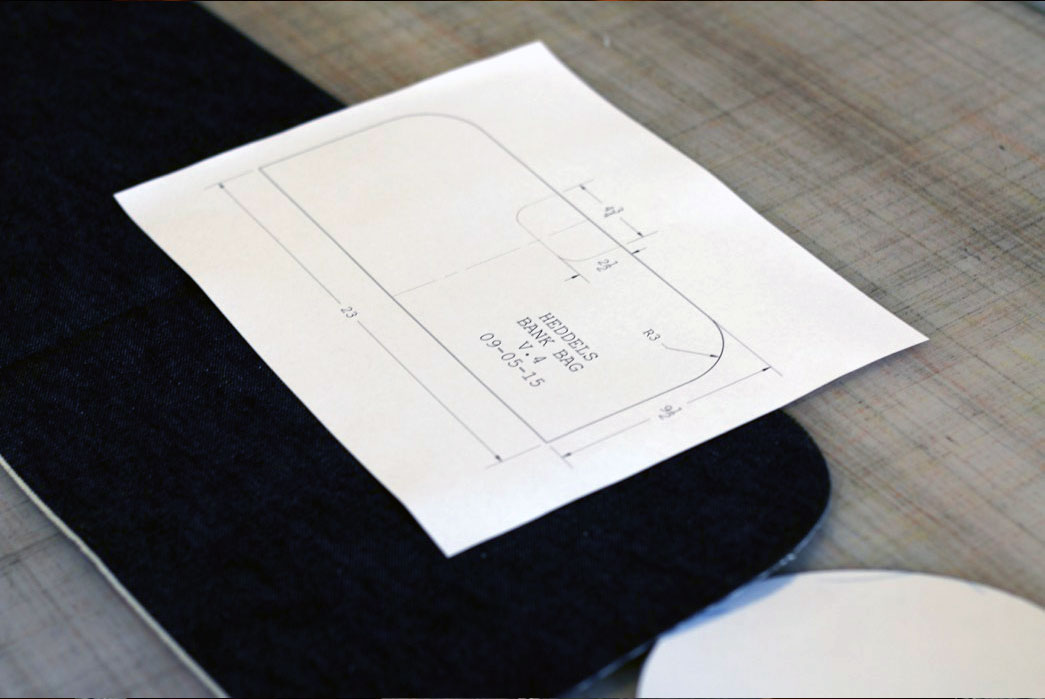
Our safety sacks arrived safe and sound, but we knew we couldn’t just do a rote copy of the original Rifkin design. The lock wasn’t necessary for the vast majority of our intended consumers, the size was a little small, and we wanted a design that could tastefully use the selvedge of our denim.
The first thing we did was rip open the original bags and see how they went together.
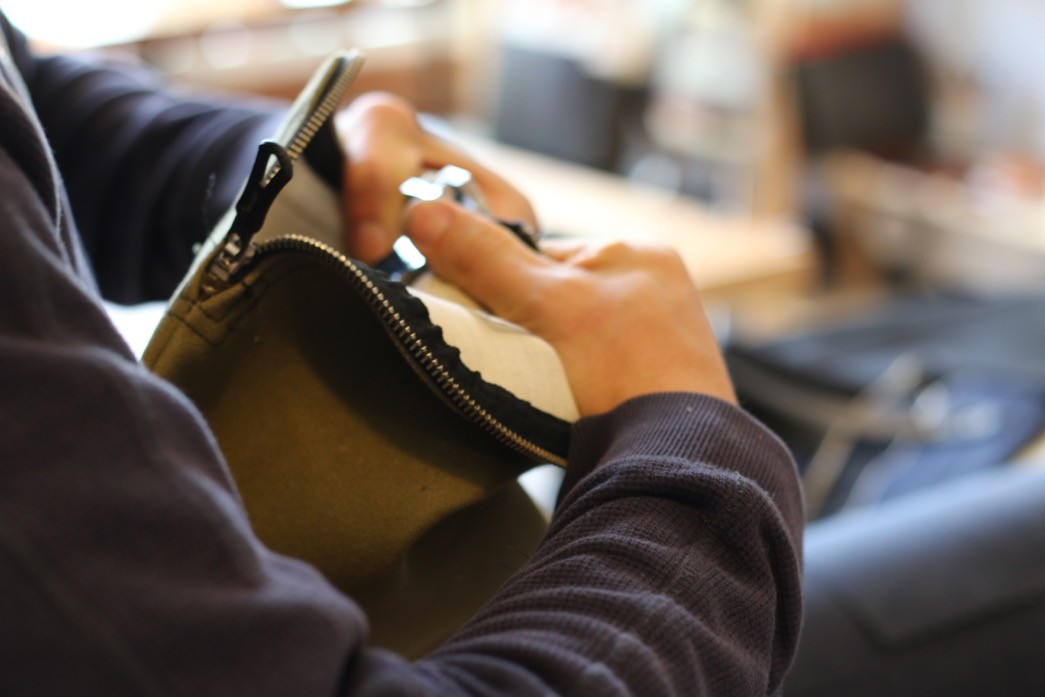
Roy and I each made our own first attempts. I think you can guess which one was made by someone who sews for a living and which was made by someone who writes about people who sew for a living for a living.
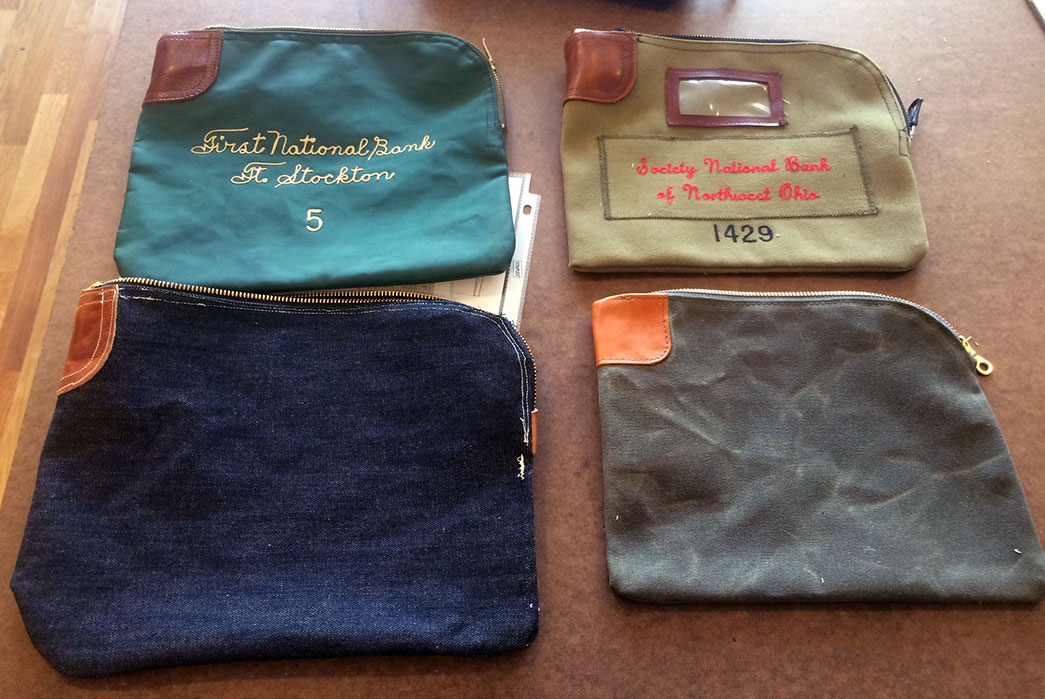
Size was pretty simple; we wanted it to be large enough to at least hold a full-size iPad, but small enough that it could easily carried alone or fit inside a backpack or briefcase. Our bag is 11 inches long and 9 inches tall.
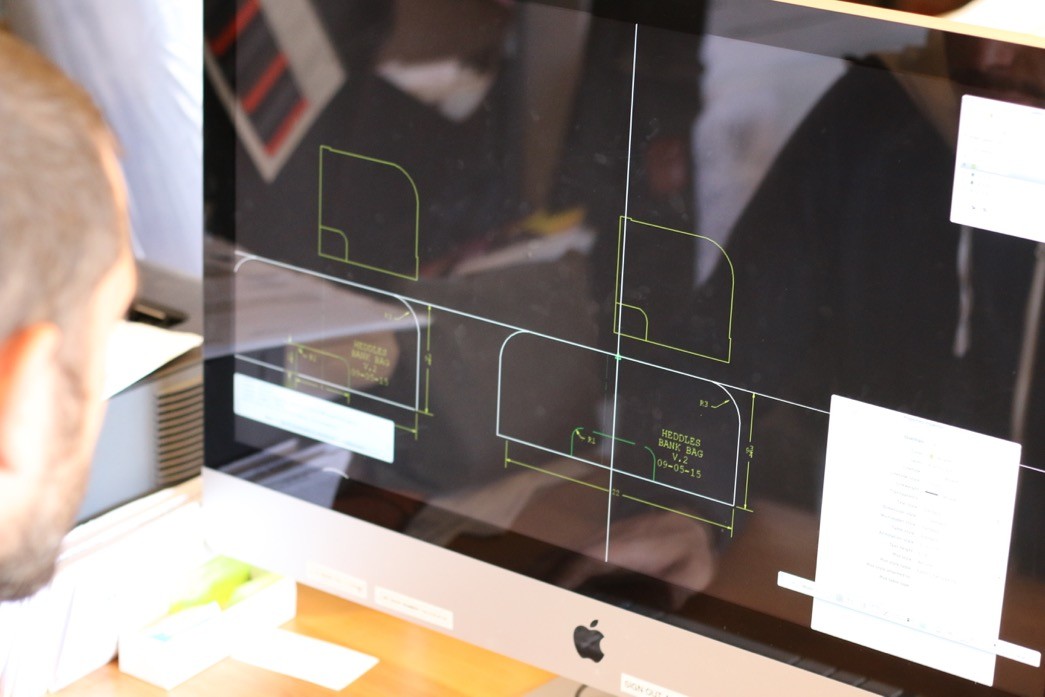
As mentioned above, the patterning process is a crazy game of spatial origami, where you have to carefully think through every step to know where seams can and will go. If we wanted to get rid of the lock, something else had to take its place.
We played around with quite a few different prototypes and the first one we settled on had a leather patch wrapped around the outer corner and a copper rivet to keep it in place at the edge of the zipper. This allowed us to keep the full two feet of selvedge along the inside seam and keep the bank bag silhouette. The plan for this run was to have the unit number punched in on the outside of the leather, hence the sample was “00”.
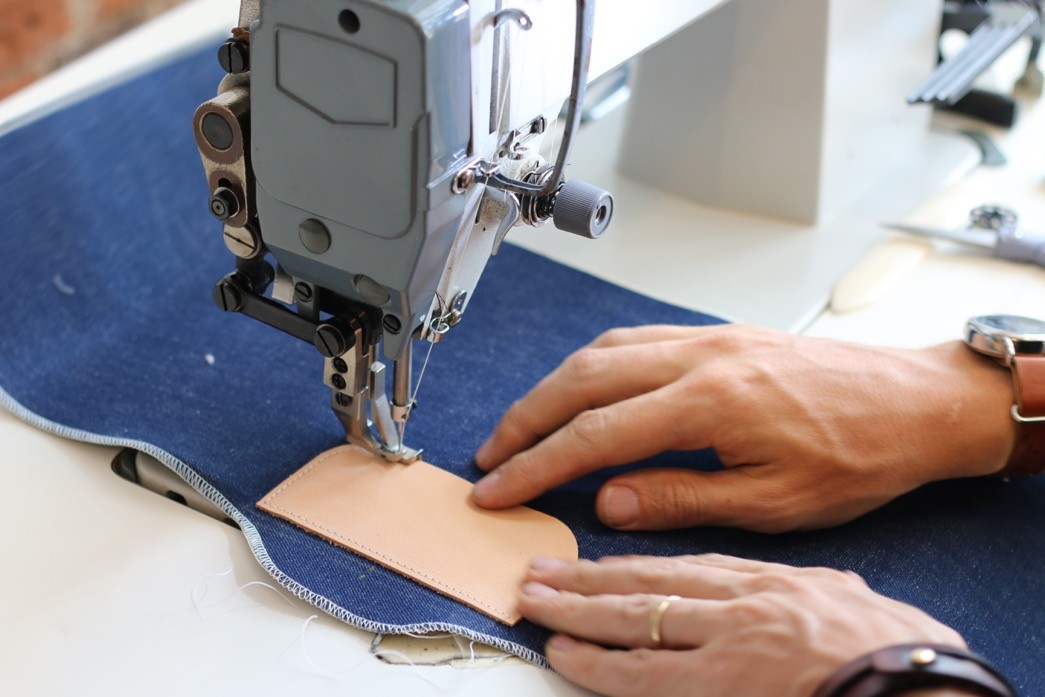
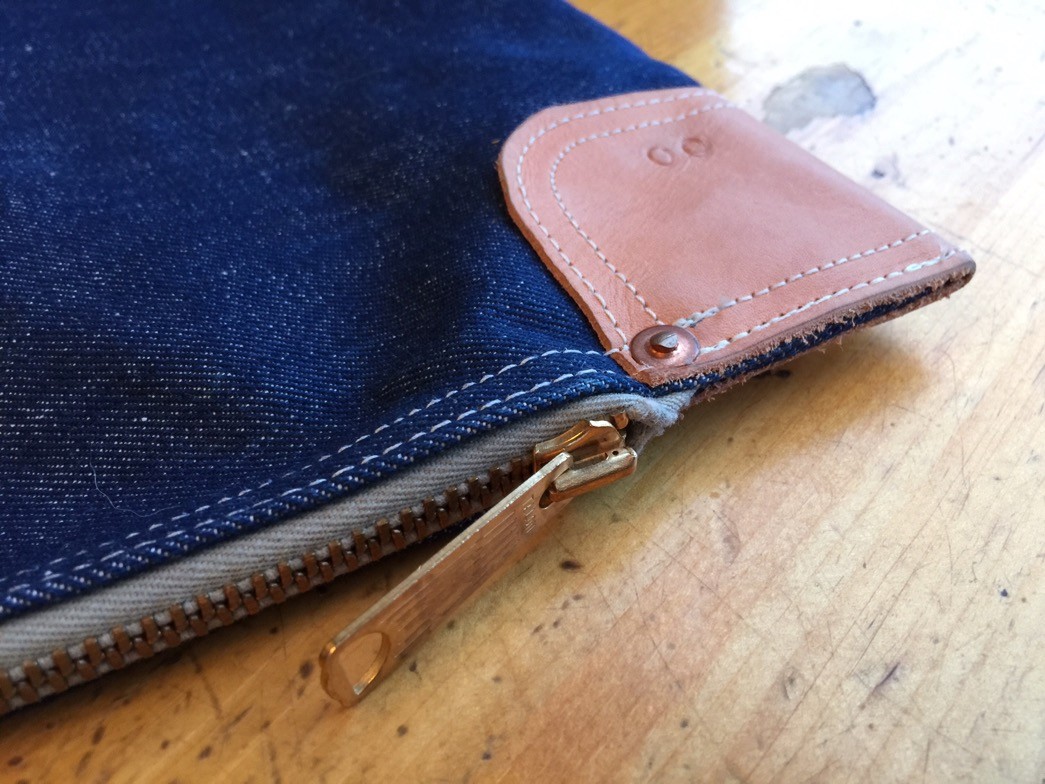
I moved to New York in September of 2015 and took the sample bag with me. After two months of field testing, I loved the size and the shape–I had never really been a “bag within a bag” type person, but I used it every day to carry my glasses, chargers, notebooks, and pencils within my backpack. I wasn’t digging, however, that exposed seam pinched between the leather.
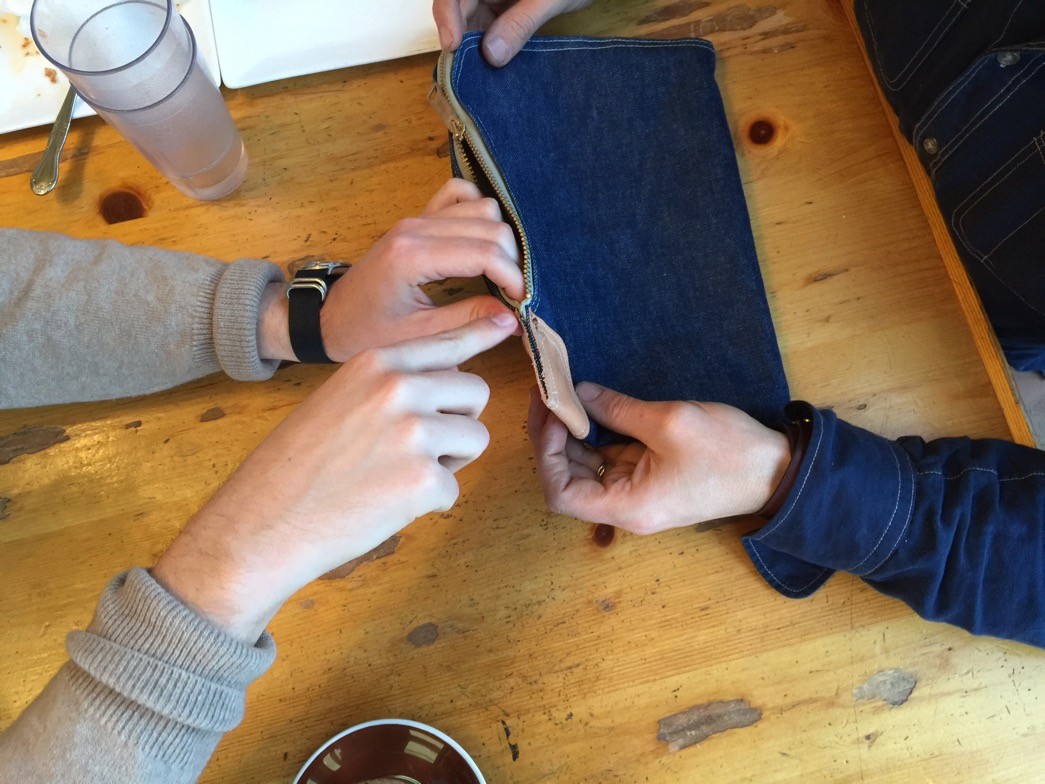
I was back in town for Christmas and met up with Roy and Tanya over lunch. There had to be something that could cover up that seam, while also accommodating our other design needs.
Roy suggested we add another flap on the leather that would cross over the seam and attach on the other side. “What if it was a pocket?” Tanya added.
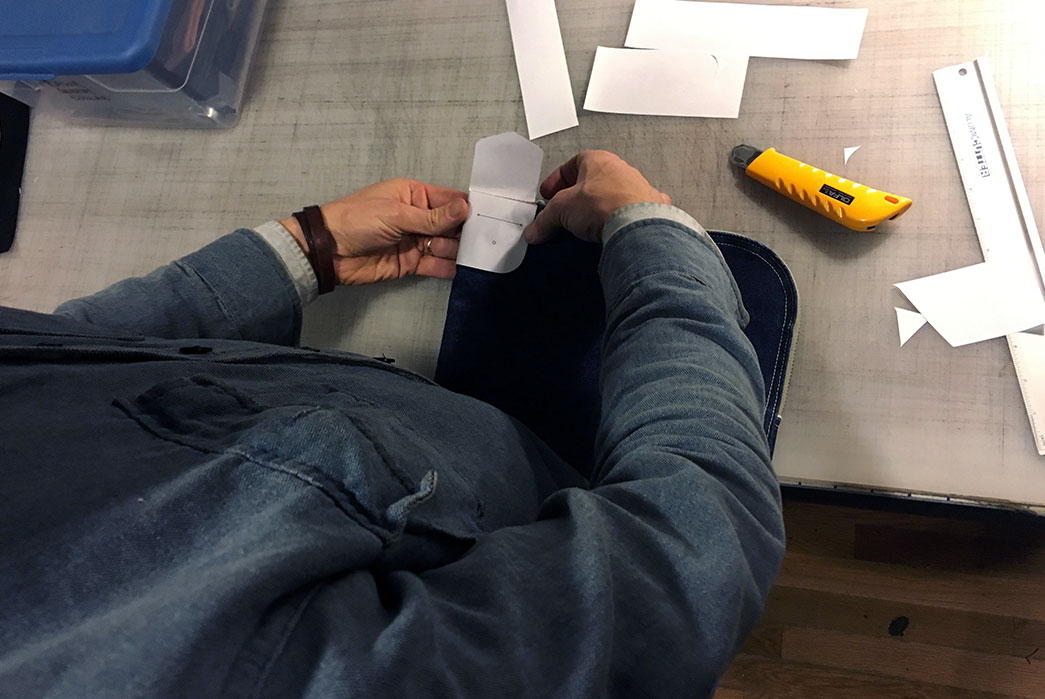
The sample paper pocket.
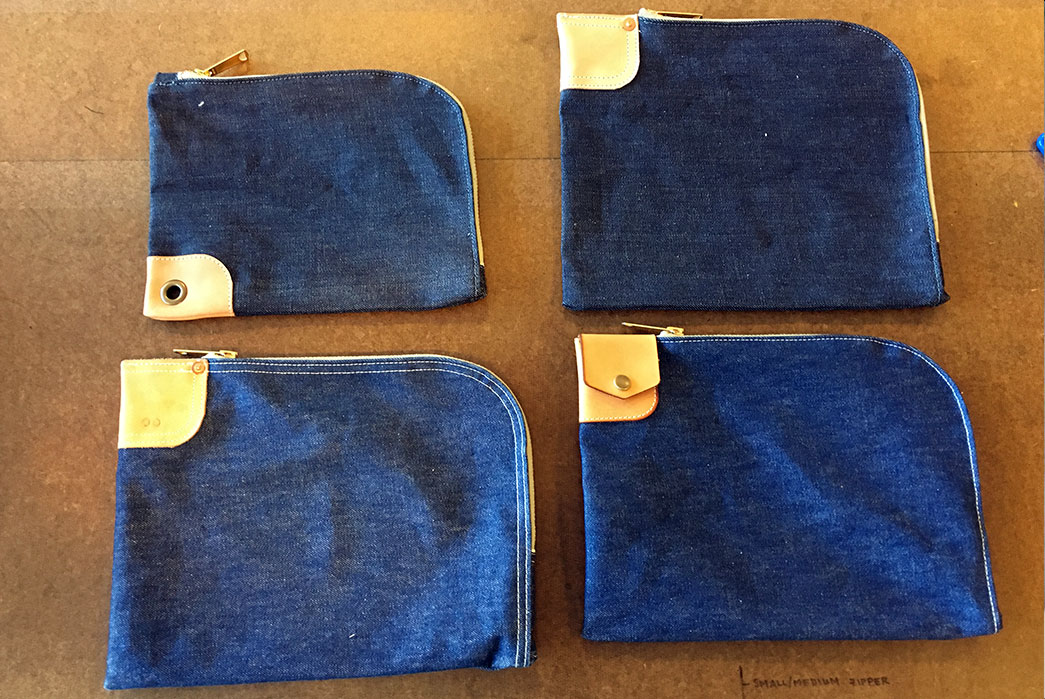
Samples two through five.
The next day, they had something mocked up on paper, and the day after that, I was back on a plane with a finished sample. This new pocket flap could even lock the zipper in place ala a the original bank bag! It’s this kind of immediate turnaround you can only get with people who make it themselves.
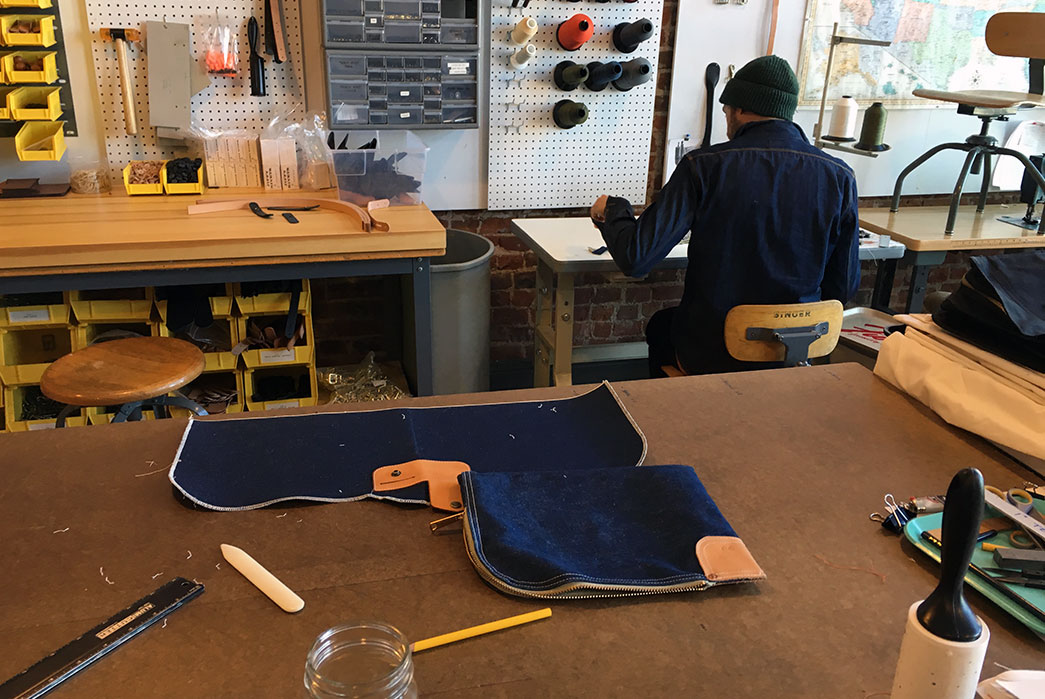
We also wanted to combine both of our brandings into a dual mark. Winter Session uses a hand from an old sign language board as a secondary logo. Roy found another hand and put a heddle in it.
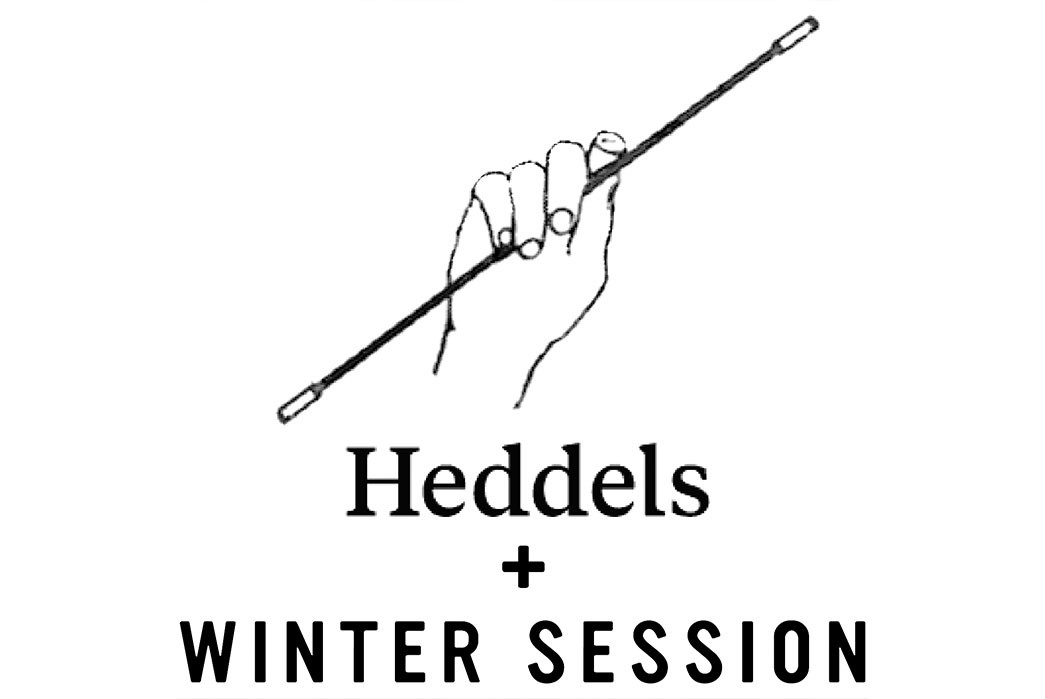
We were ready to make bags.
Production
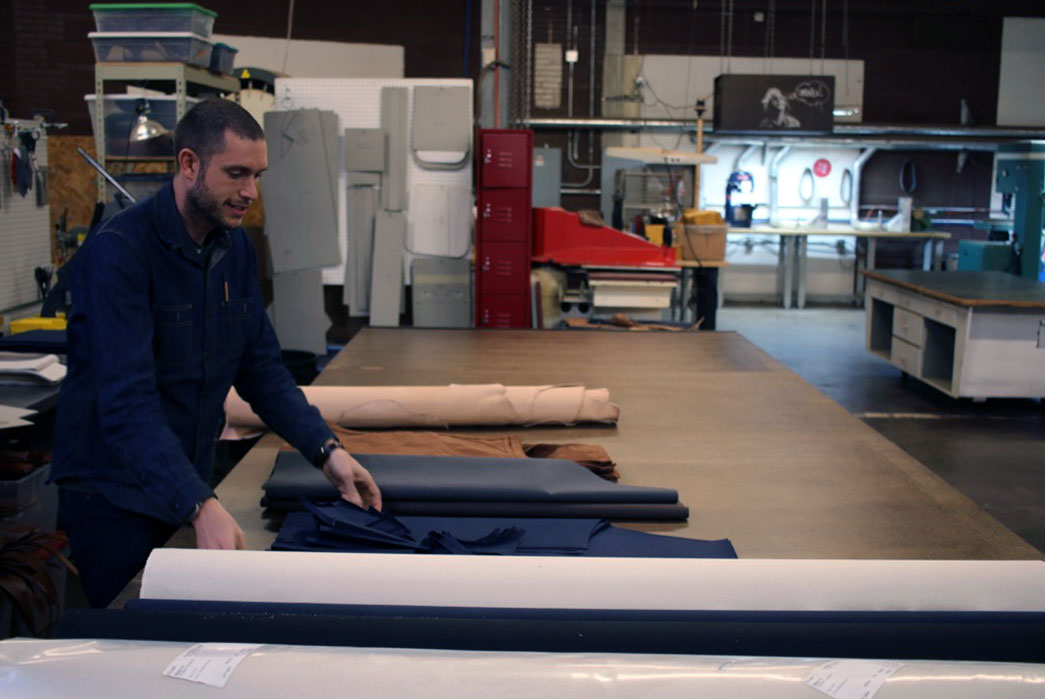
After we settled a few little details–interior artwork, larger opening on the leather pocket, double top stitching on the zipper, leather lace zipper pulls–the Winter Session team got to work.
The first step to make a bank bag is cutting the leather for the flap. Winter Session gets half cow hides, or sides, of about 25 square feet from Hermann Oak, which need to be cut down into more manageable pieces.
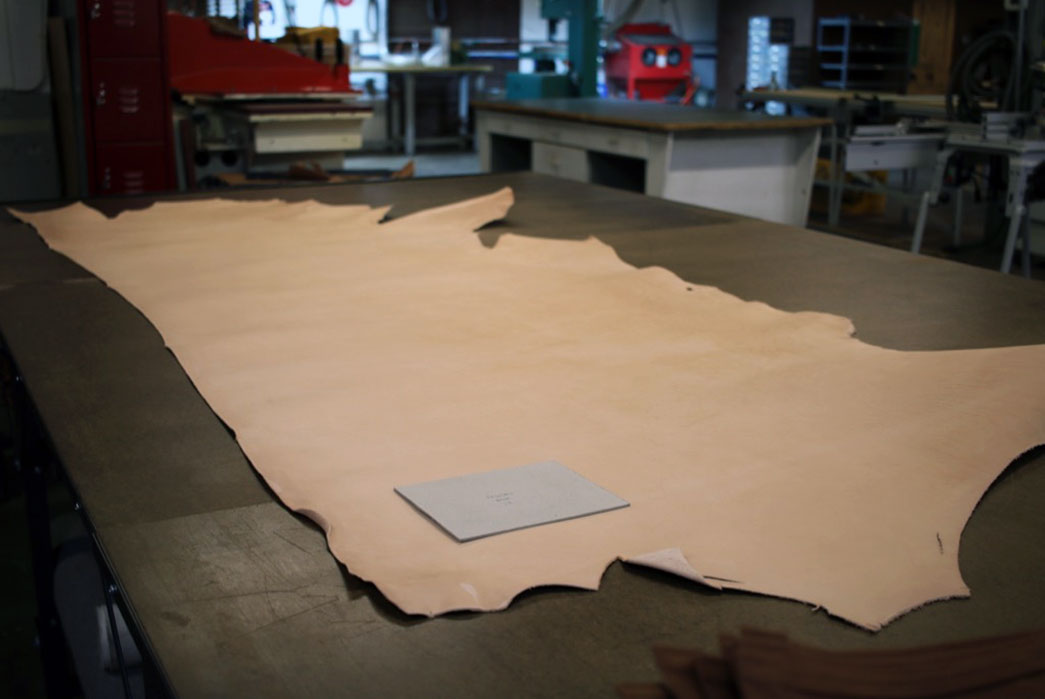
See that little cardboard square? That’s the pattern blank for two of our leather patch flaps. We ended up using a whole side to make all of the bags. Thanks, half-cow.
Once the pieces are cut into manageable sections, they head off to the laser cutter!
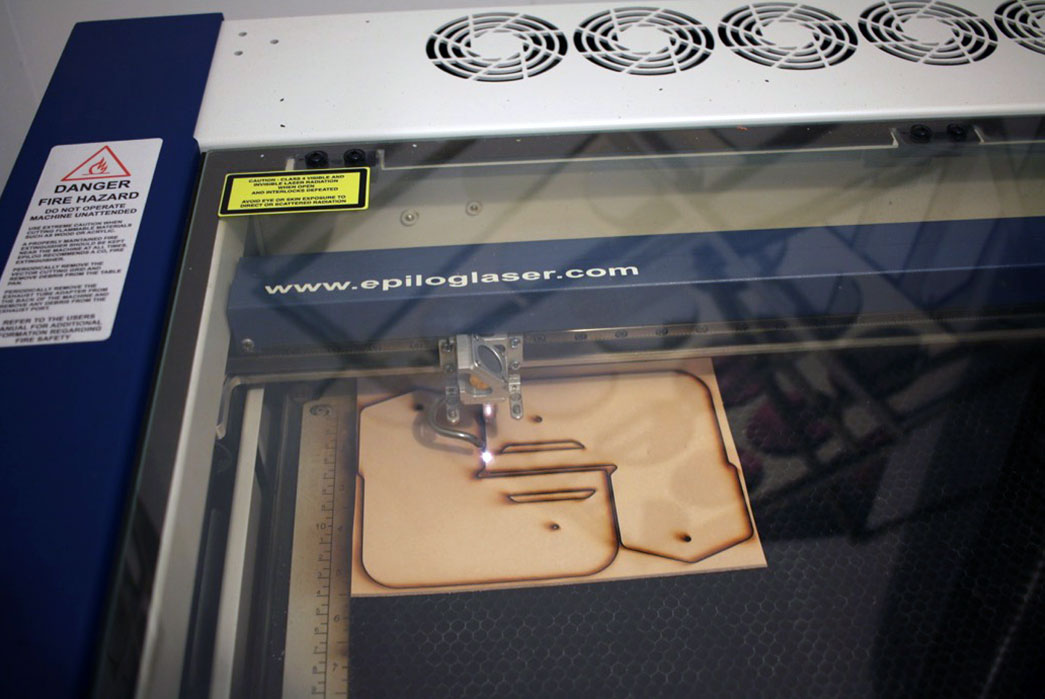
Winter Session’s laser cutter can slice and engrave whatever shape or design you so desire. For us, that meant the L-shaped leather corner piece with holes for the snap button, the pocket slit, plus engraving our branding and unit number on the upper flap. The laser makes a perfect cut with a clean edge, and it also leaves behind a bit of char, which will ebb away with use. You’re not supposed to look at the light emitted by the laser directly, but it’s WAY too cool not to.
I was able to catch it mid-pass while burning in the Winter Session logo. The blurry bit of silver at the top of the image is the laser arm as it shuttles back and forth on the image and the white sparks are where the leather is burning away.
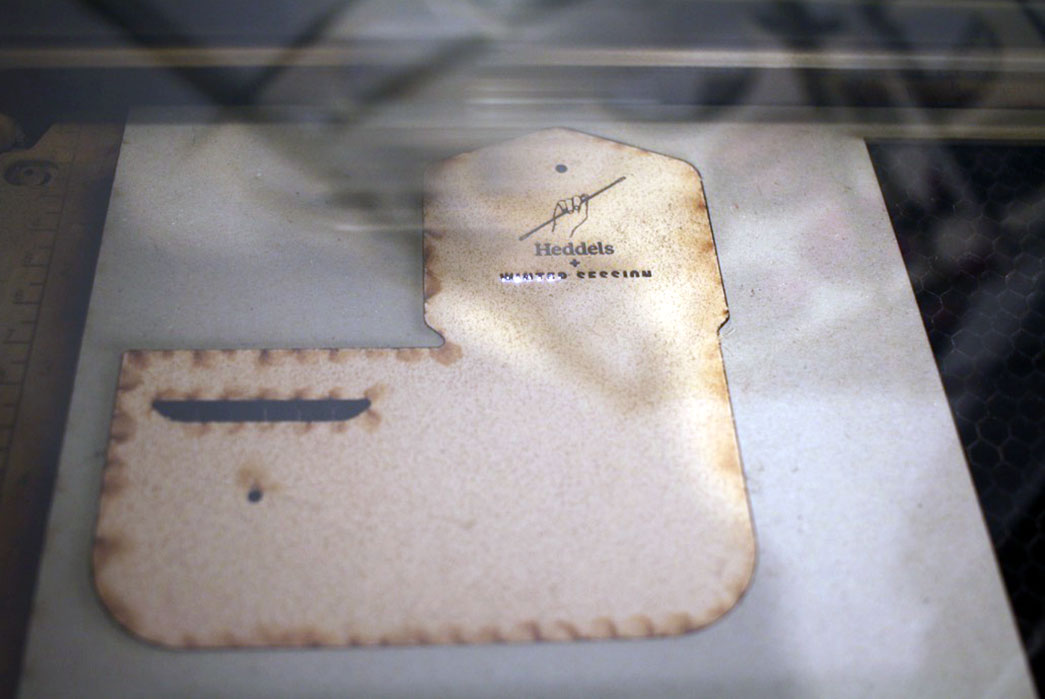
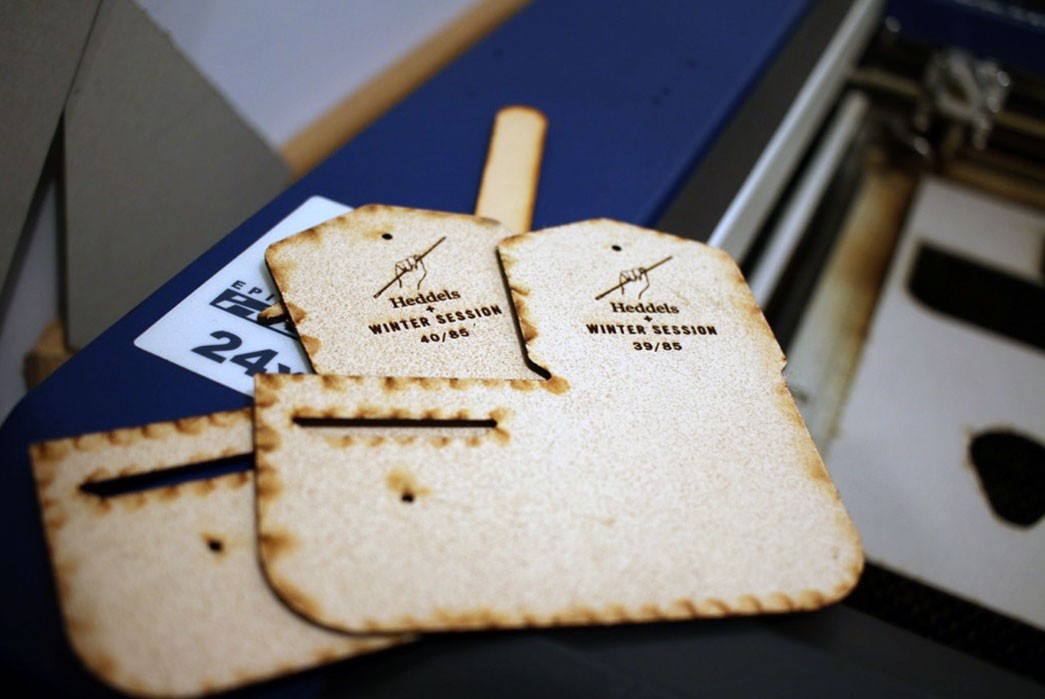
The next step is cutting and serging the fabric. Every bag required a little over two feet of selvedge for the bottom seam plus a couple inches for the detail on the zipper.
We had 30 yards of fabric (minus a bit we used for sampling) so that added up to a little less than 180 total feet of selvedge, out of which we were able to squeeze 85 units.
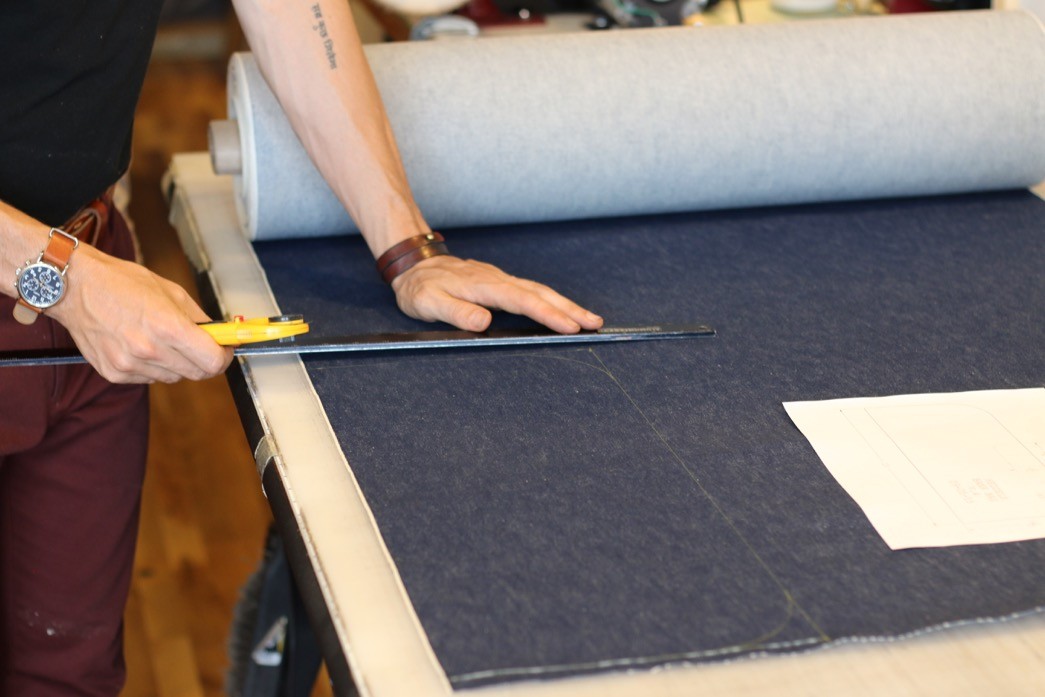
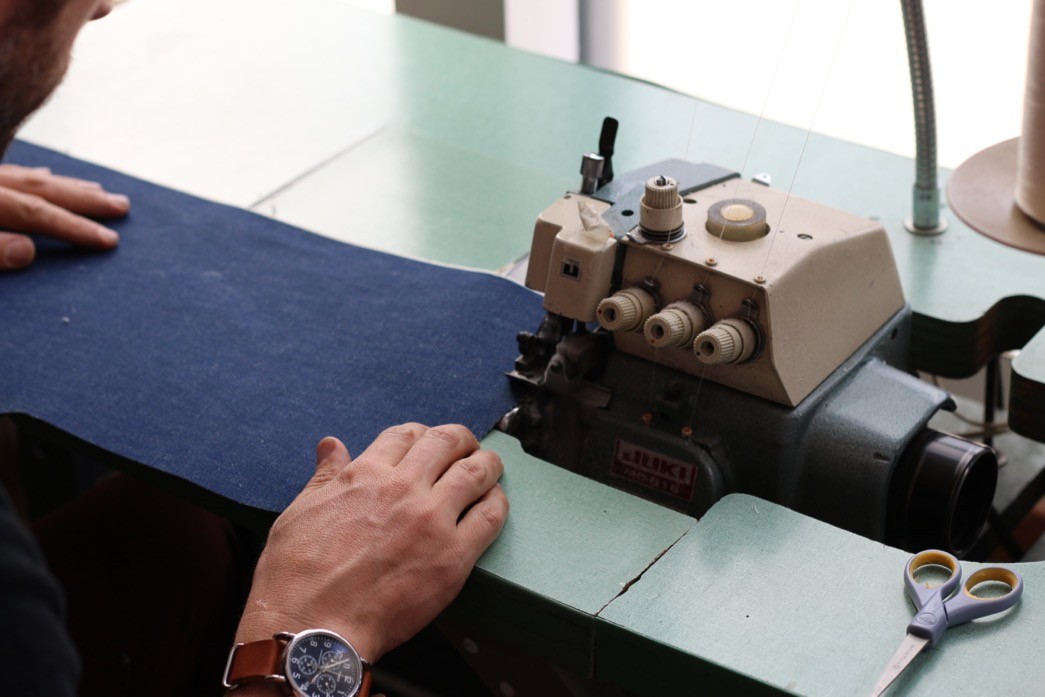
After serging the raw edge of the denim, the leather patch gets a snap pressed into it and is then sewn onto the denim. Then the zipper gets a selvedge endcap sewn along its end, and that whole piece is sewn onto one half of the opening.
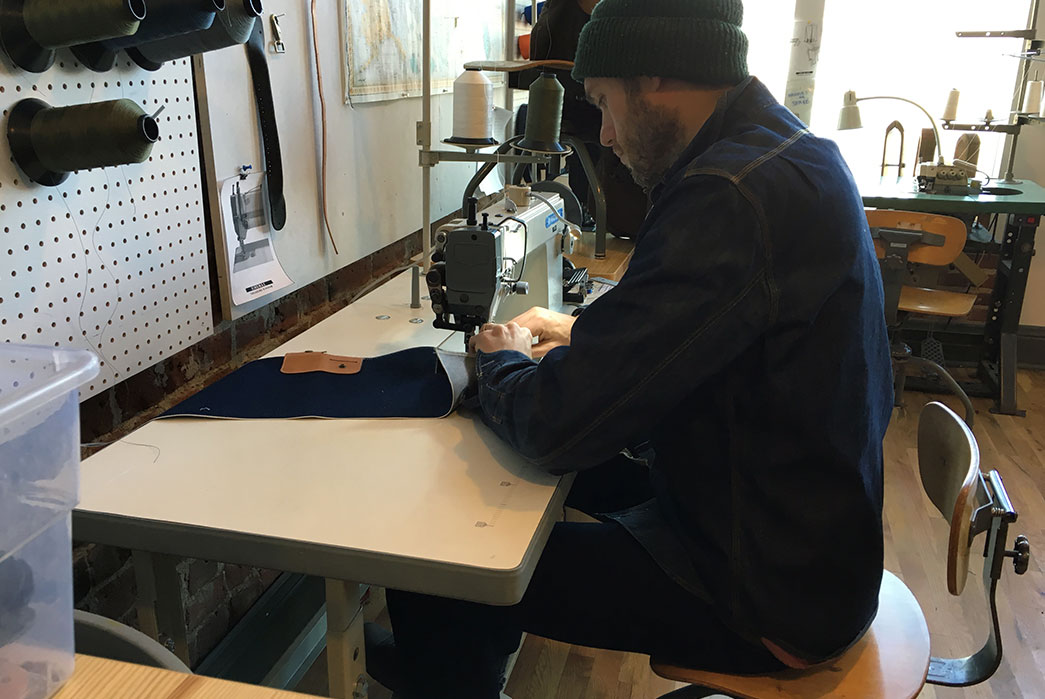
Winter Session uses industrial single-needle sewing machines, primarily Jukis and Singers. Some of them are a bit older, but none were acquired specifically for the vintage appeal–they just need to work and work well.
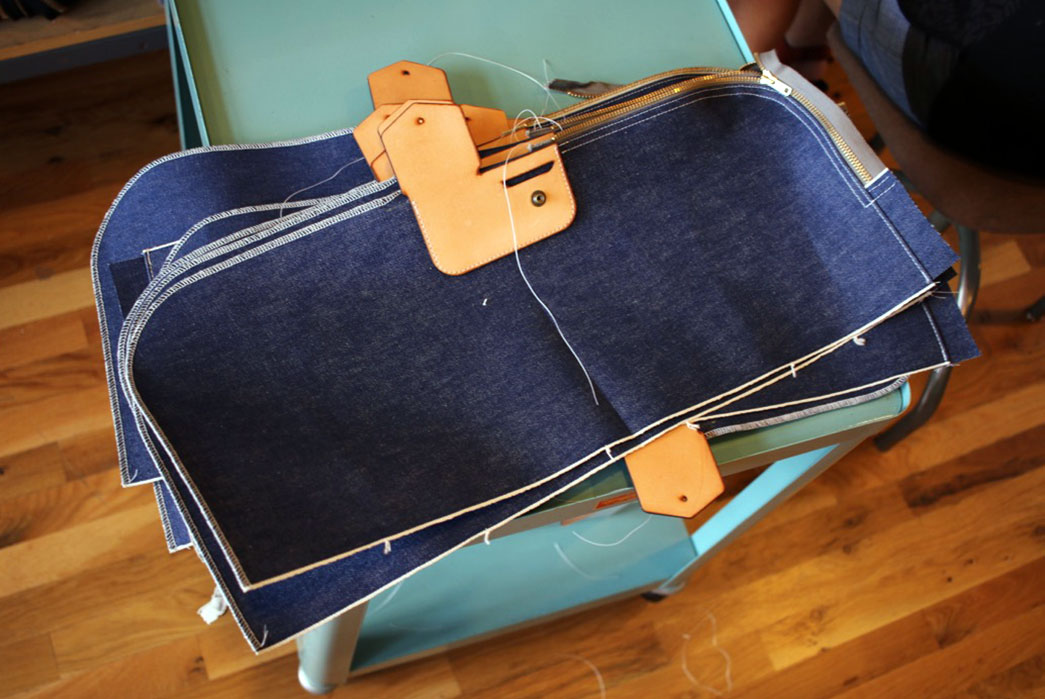
The two sides of the bag are then are sewn together, leaving the selvedge running along the bottom seam of the bag and a double topstitch along the zipper.
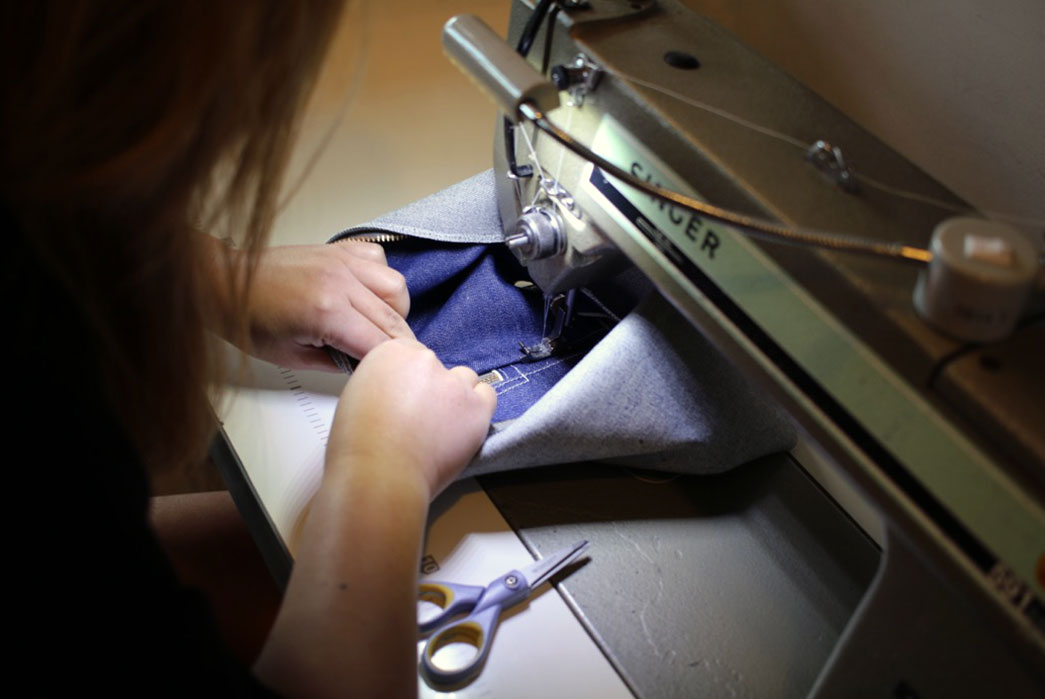
Connie sews the first topstitch pass on the far side of the zipper.
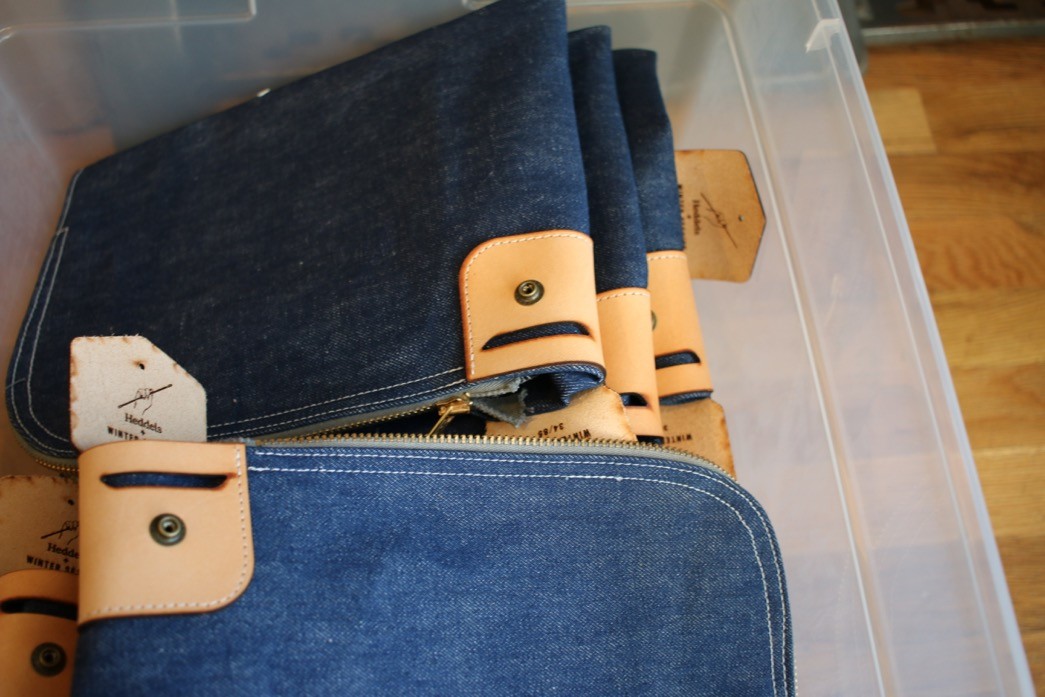
The snap button is pressed into place and the bag awaits its most difficult step.
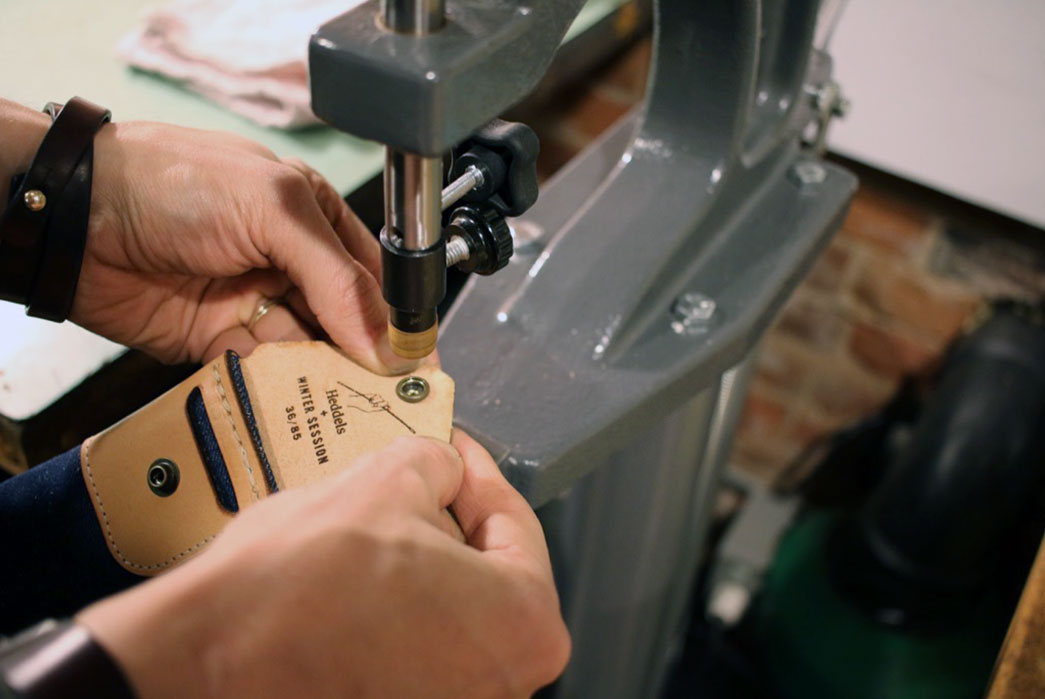
The top corner needs to be sewn shut, but this corner is no ordinary seam–the thread will have to pass through two layers of leather and four of denim. Luckily, Winter Session has no ordinary sewing machine.
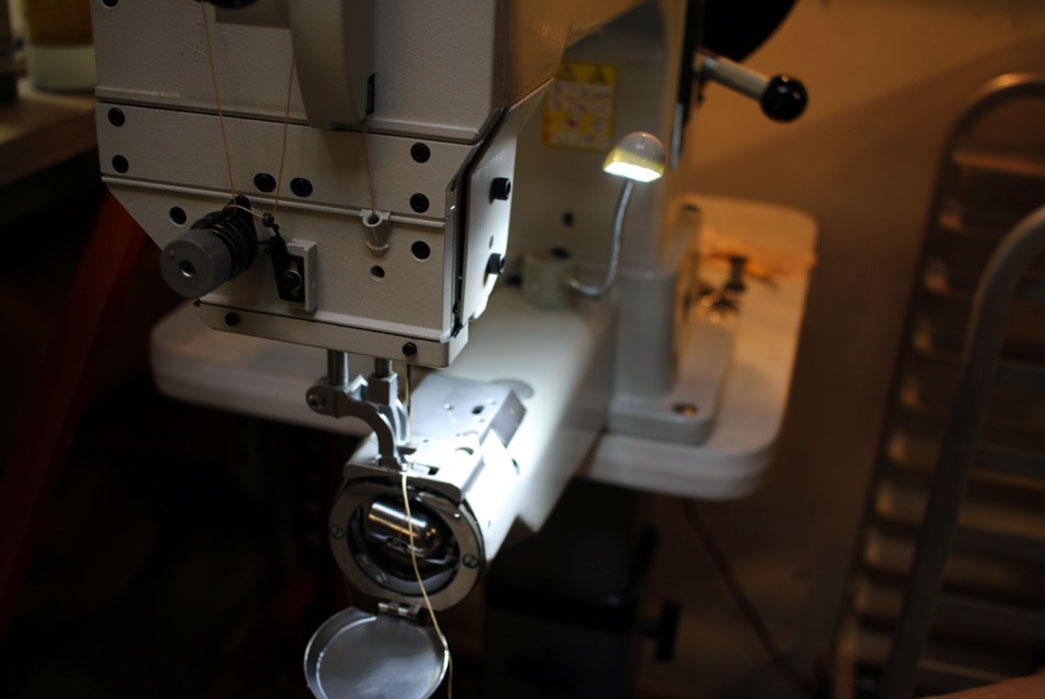
This terrifying behemoth sews Winter Session’s bag handles and could probably sew through sheet metal if your spot welder was acting up. It handled our bag just fine.
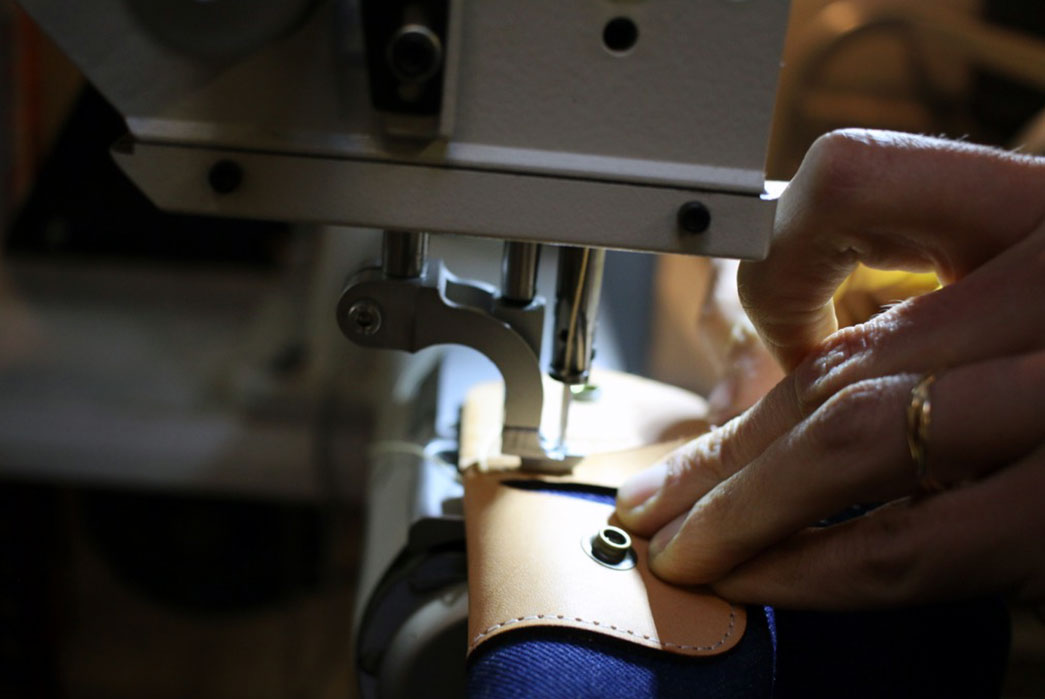
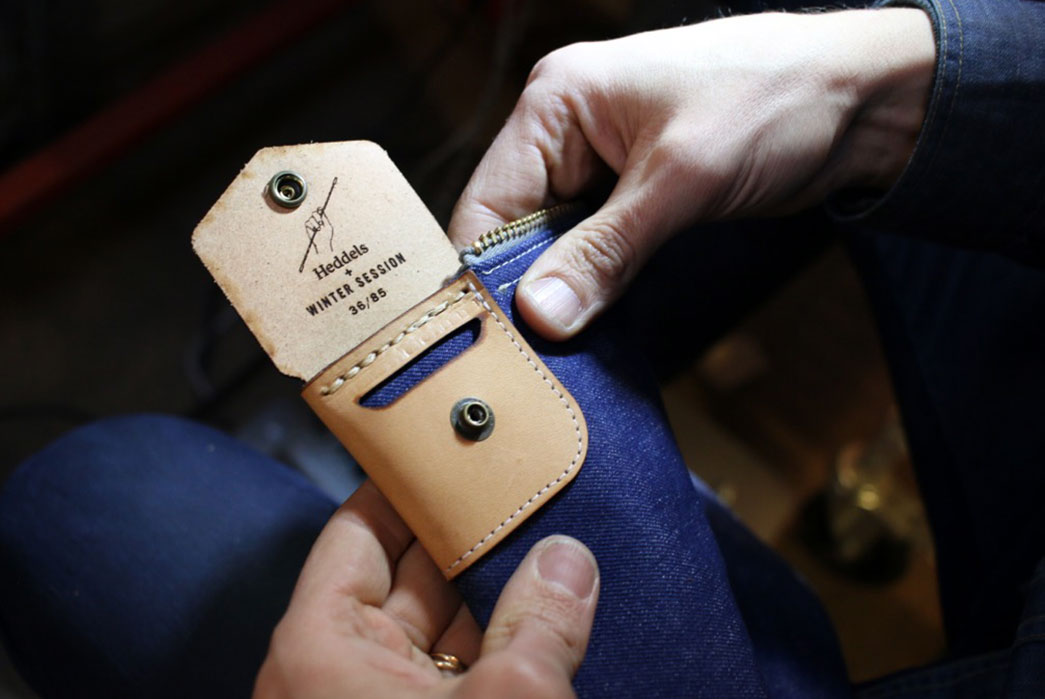
Finally, the zipper gets a veg-tan leather lace on the pull, and the bags are good to go.
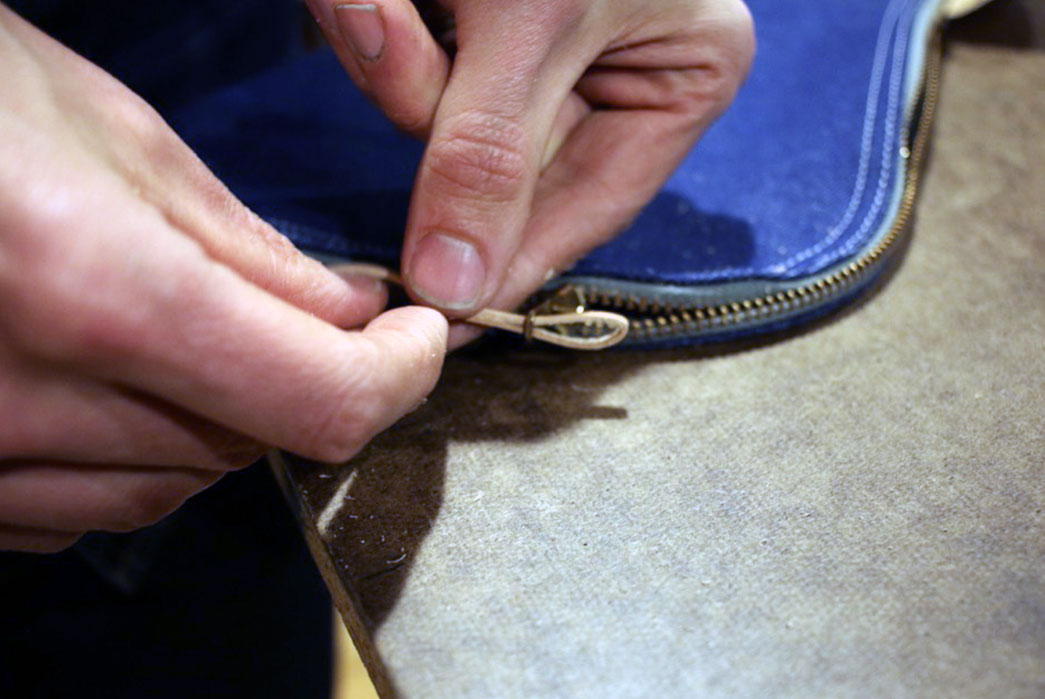
Look, the lace and the zipper even locks in under the flap just like a real bank bag!
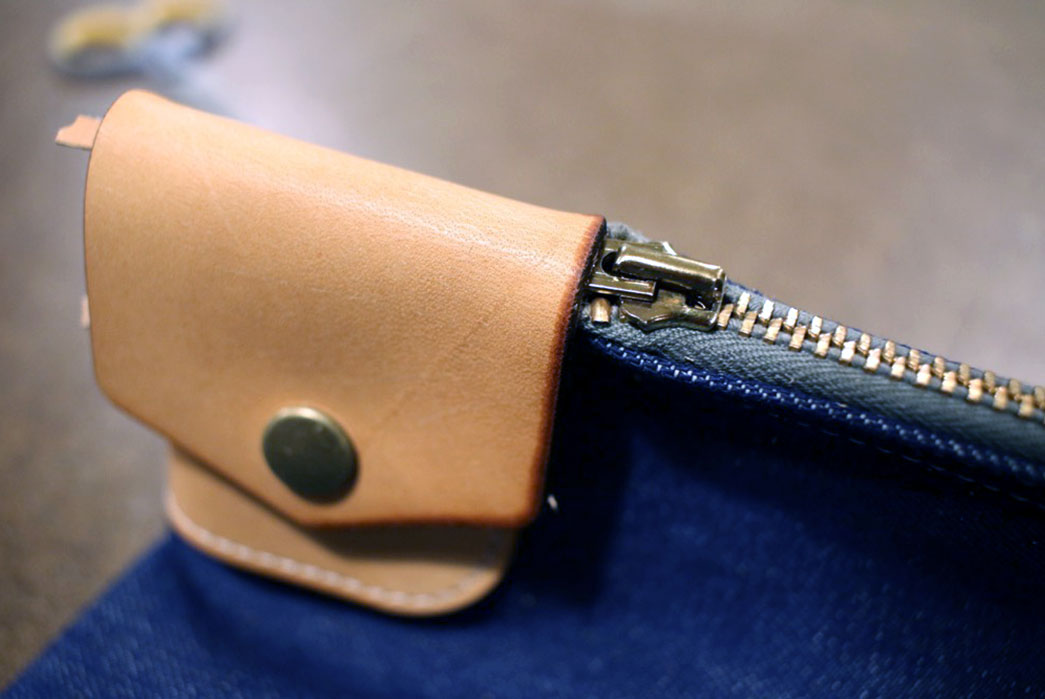
The lovely Winter Session people who made the bank bags are (from left, below) Cher Crichlow, Tanya Fleisher, Connie Hong, Roy Katz, Charla Bultman, Ashley O’Brien, Sabrina Kuratomi, Mark Anderson, Joel Niemann, and Whitney Larson (not pictured).
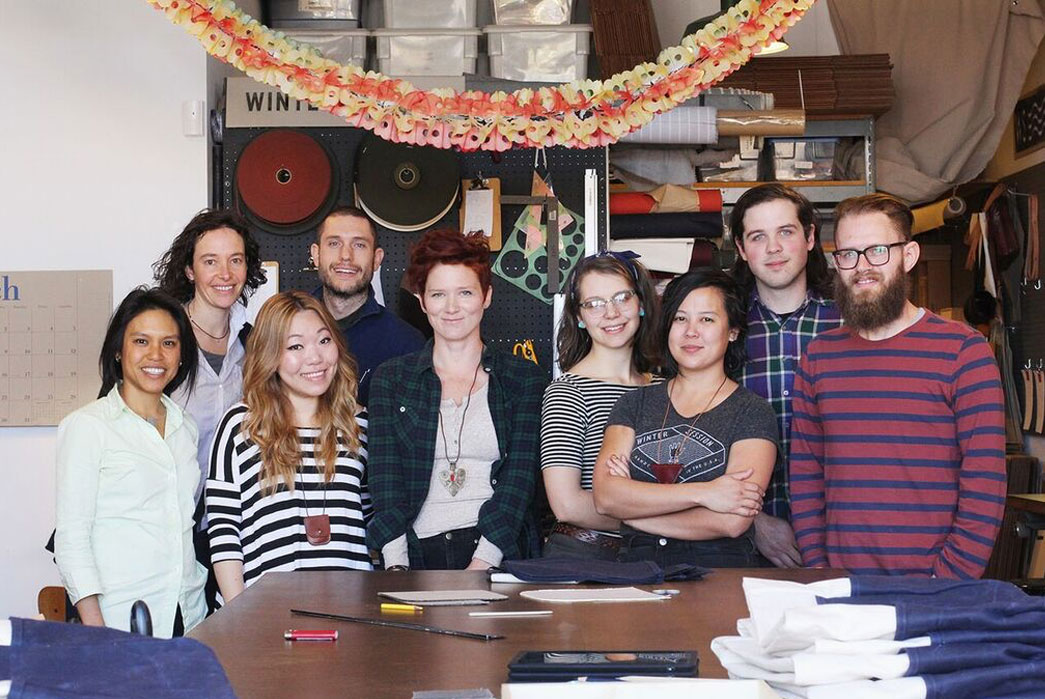
The Party Favor
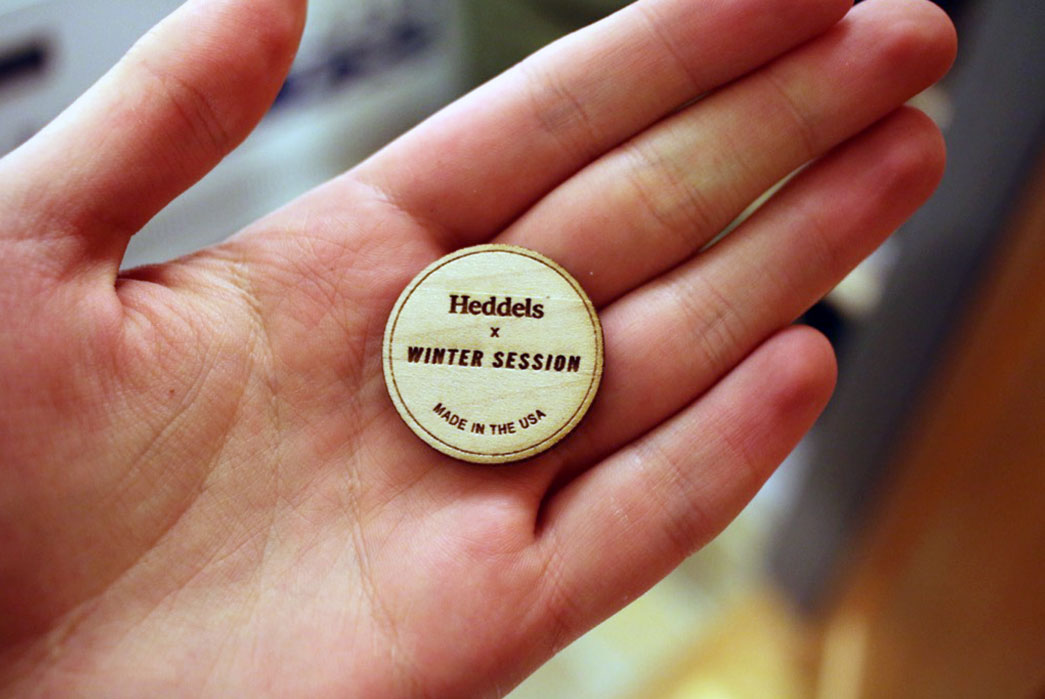
Rule number thirteen of our CO-OP manifesto states that every product has to be “accompanied by a relevant souvenir.” Since this project is a bank bag and it’s all taking place in Denver–one of four American cities to be blessed with a mint from the U.S. Treasury– we decided to make a wooden nickel. Plus, the bag basically comes with a coin slot.
Not only can Winter Session’s laser cutter slice through leather, it does short work of wood as well. We tested out a variety of hardwoods and eventually decided on cherry.
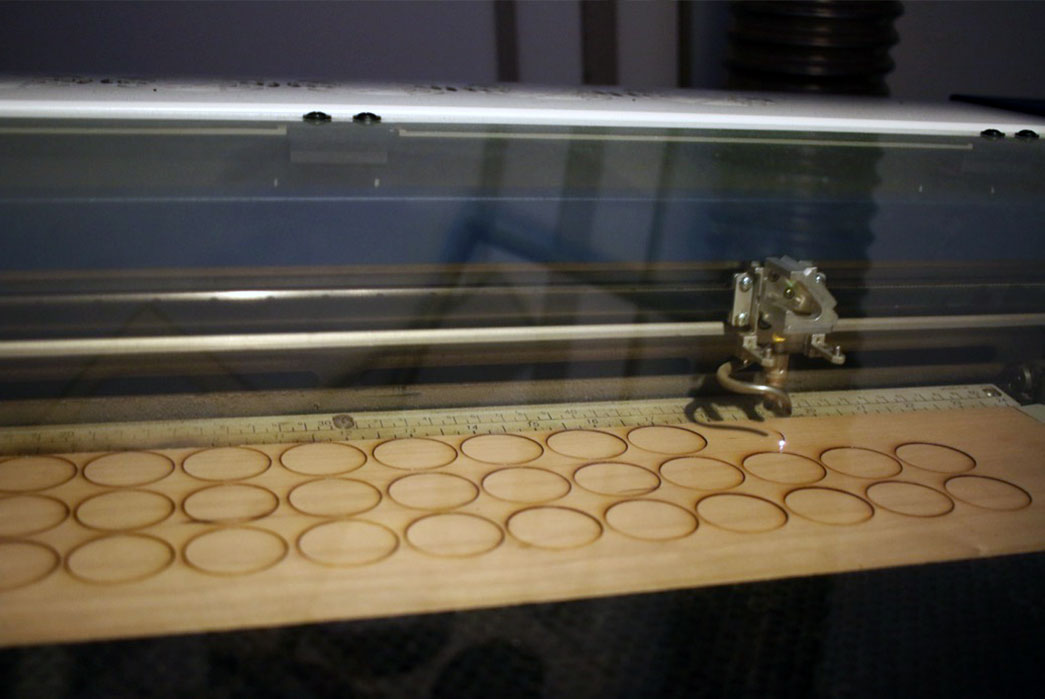
Check out the vid of the laser engraving in action!
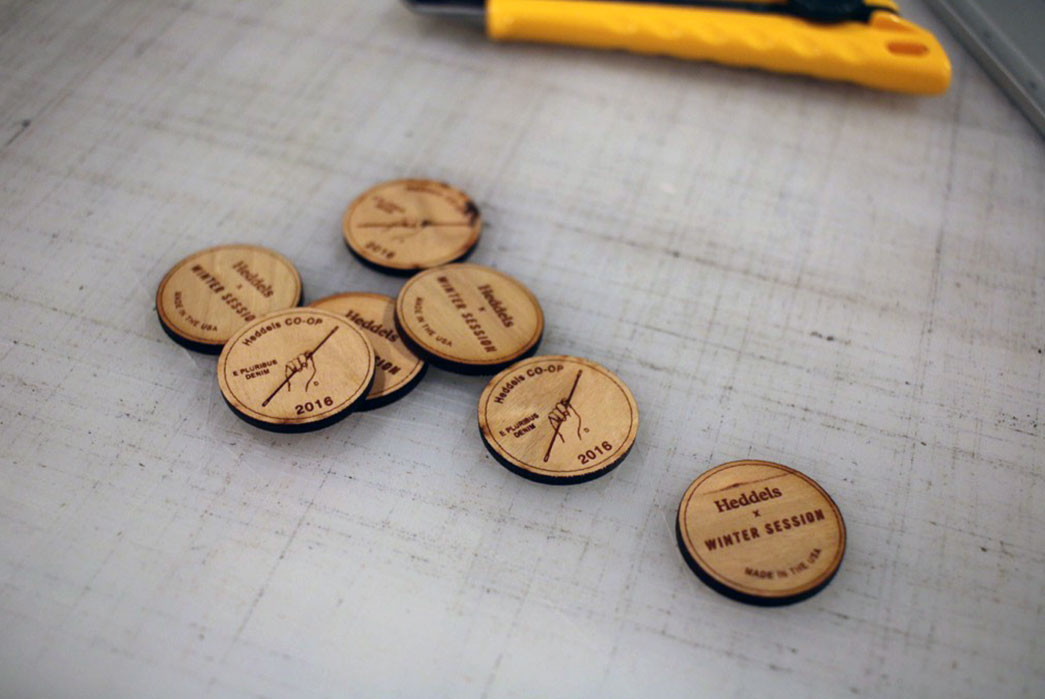
Yep, that says “E Pluribus Denim”.
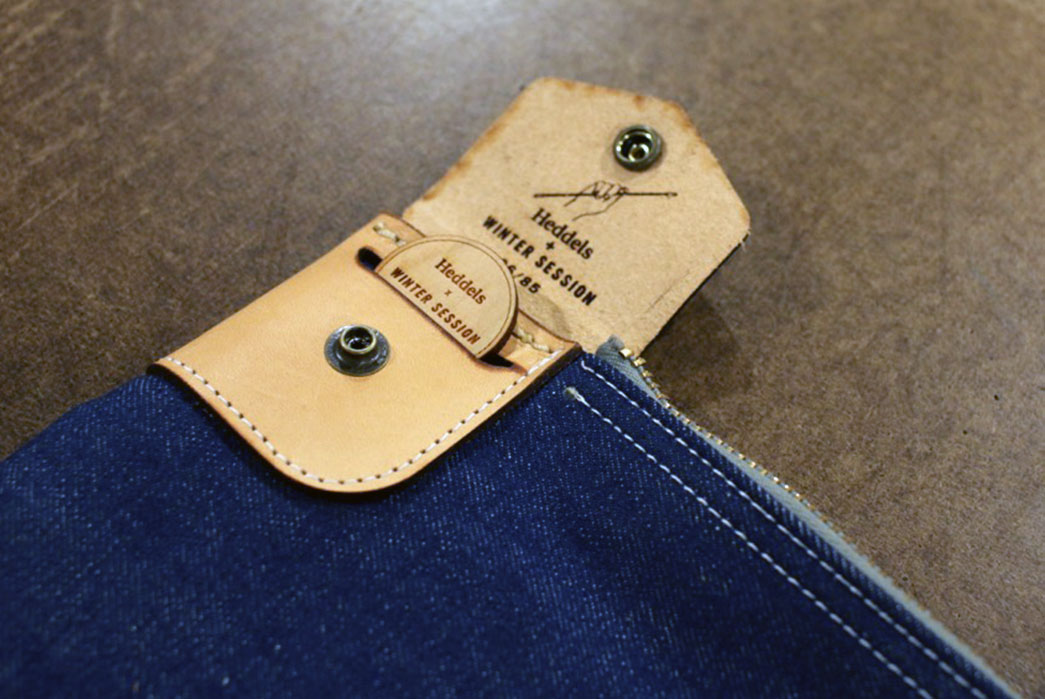
And this wooden nickel is more than just a keepsake. You’re welcome to hang on to it, but you can also bring it back, IN PERSON to the Winter Session workshop in Denver for 15% off your next purchase and a free t-shirt.
We’ve also included a special mystery item with the nickel, but you’ll have to buy it in order to find out what…
Packaging
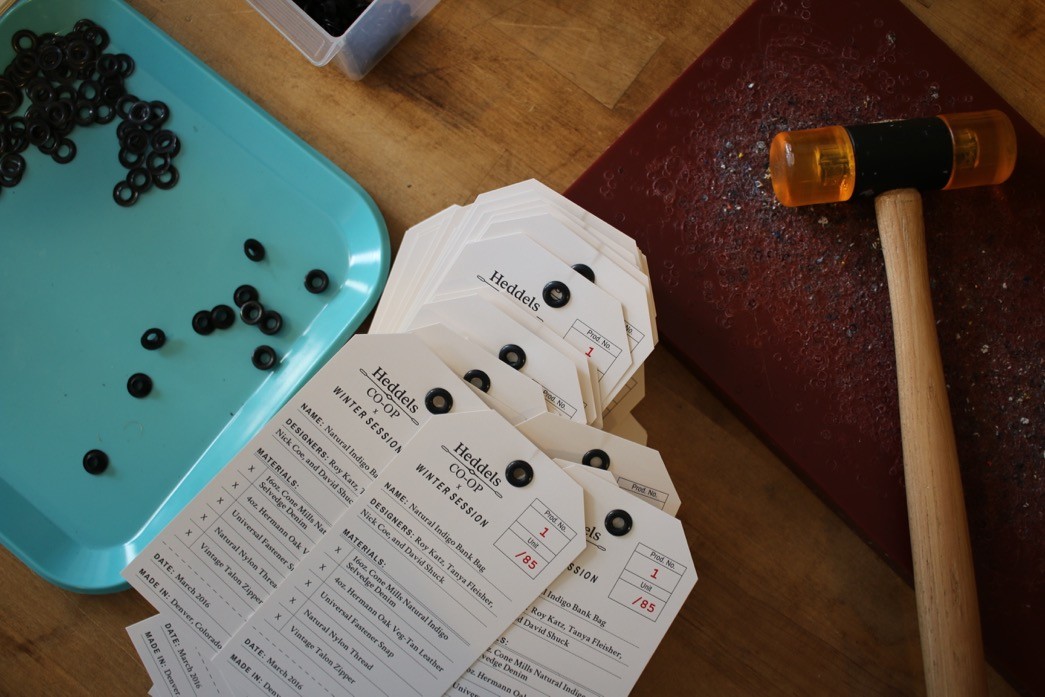
We based our tags on old dry cleaner and tailor alteration tags. The final design was done up by Nick’s brother, Steve.
It’s the same size and shape of a number 8 shipping tag and lists the names of the collaborating brands, the product number (one in this case), the unit number for the run, the product name, designer names, material names, the release date, and where the product was made. This will be the tag template for all CO-OP products.
We printed the tags at Excel Press, a local print shop in Denver also did our Christmas card a couple years back. There’s me attaching the grommets to each tag below.
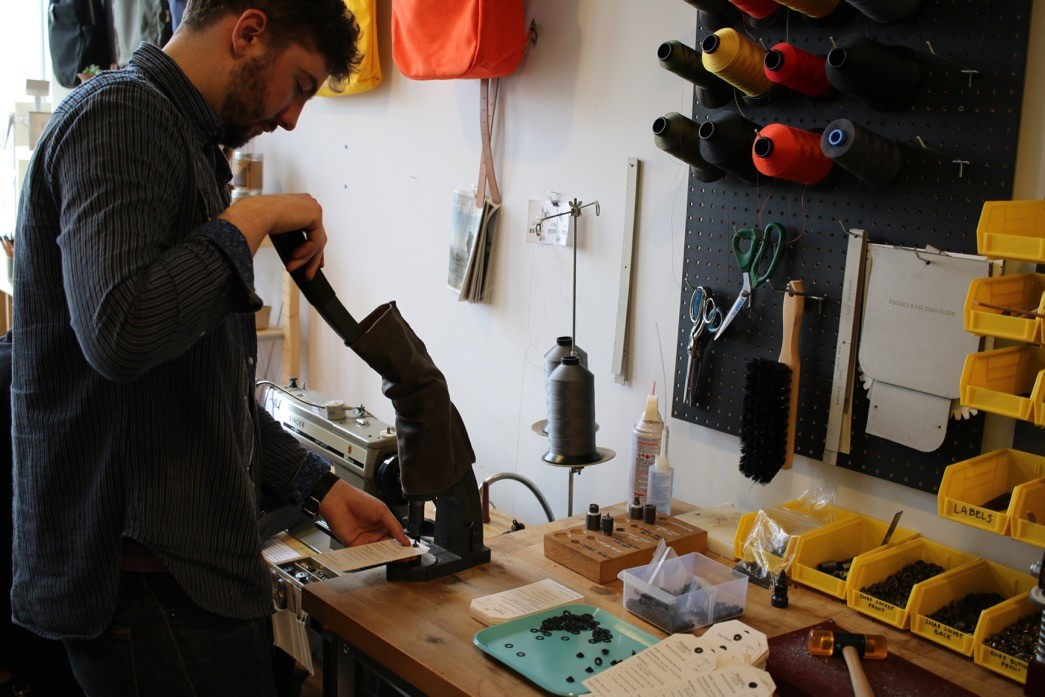
We’ll handwrite the corresponding unit number on each tag as it’s attached to its corresponding numbered bag.
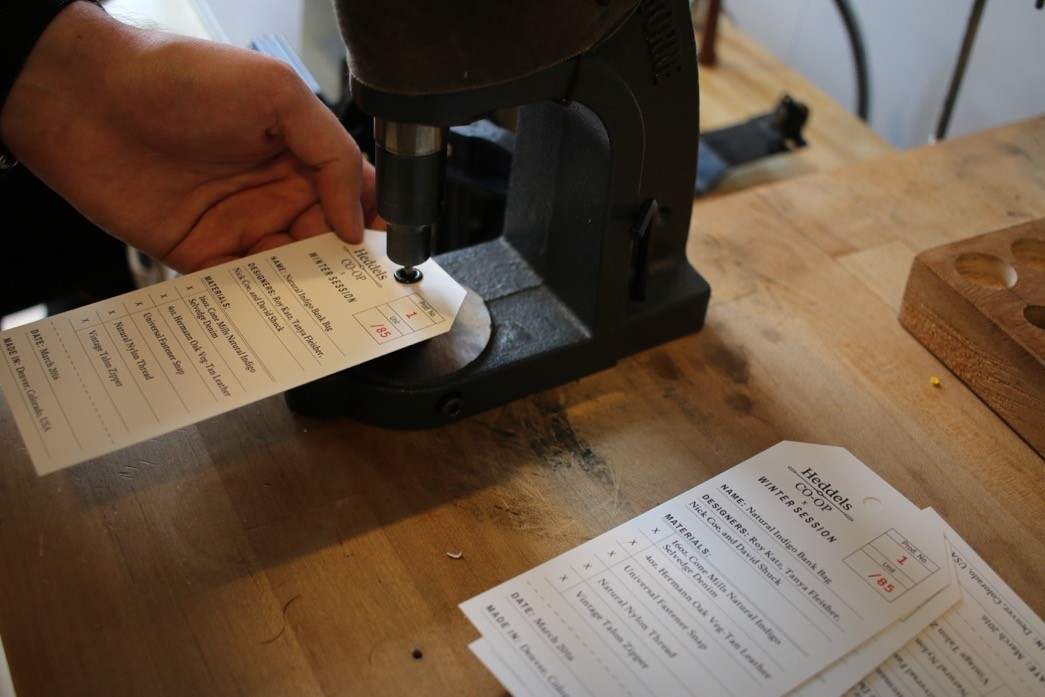
The Rules
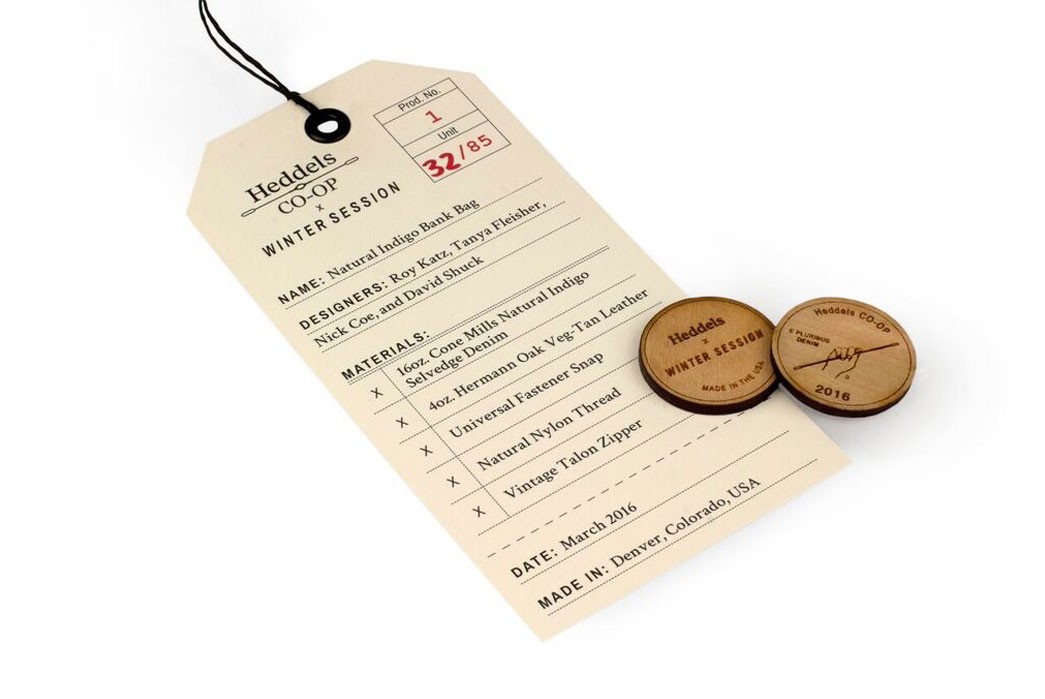
So the entire purpose of these collabs is to follow a strict series of rules we laid out at the start of the project. Let’s see how we did:
1. All source materials must be minimally processed, raw, and undistressed.
The denim is raw, the leather is natural veg-tanned. The zippers, thread, and wood are all completely untreated.
2. The source and contents of all materials and hardware must be made explicit.
The fabric is 100% cotton 16oz. selvedge denim woven at the Cone Mills White Oak Plant in Greensboro, North Carolina. The leather is 4oz. natural veg-tanned cowhide from the Hermann Oak tannery in St. Louis, Missouri. The thread is nylon from American and Efird. The zippers are brass vintage Talons with cotton tape. The snap button is from Universal Fastener. All bags were cut and sewn in Denver, Colorado, USA.
3. Design, sourcing, and production decisions must be made to produce the best possible product. Cost considerations must be secondary.
Trust me, there were dozens of easier and cheaper ways to make this bag, but this is the best iteration that it took us months to arrive at.
4. Products must be wholly original to collaborating brands in design, name, and material.
The bank bag’s silhouette, denim, and name have never before been used by Winter Session and (save the denim) were designed exclusively for this project.
5. Products must represent the joint decisions of Heddels and the collaborating brand. The process will be a true collaboration, not a private label or made to order good.
It’s difficult to tell where our decisions ended and Roy and Tanya’s began and vice versa. This was a true collaboration where both sides were intimately involved in the process
6. Products must be limited, numbered, one-time-only releases. Collaborating brands may continue to use a CO-OP developed design but never the exact makeup as the CO-OP product.
We made 85 bags and there will be no more. Winter Session may reproduce this design, but it will be with different materials.
7. No more than 500 and no less than 5 units of a CO-OP product will be produced.
As above, we made 85 bags.
8. Heddels must physically visit and document where the product is made and the people who make it.
I spent so much time in the Winter Session workshop in Denver. If the photos above are any suggestion, I was basically their Kramer for a couple months.
9. Every individual involved in the creation of the product must be credited by name.
The people involved in the creation of the bag were myself, Nick Coe, Cher Crichlow, Tanya Fleisher, Connie Hong, Roy Katz, Charla Bultman, Ashley O’Brien, Sabrina Kuratomi, Mark Anderson, Joel Niemann, and Whitney Larson.
10. Products cannot be sold until the product is on hand and paid for by Heddels. No crowd-funding, no pre-sales, no net 30.
The bags exist, and we will have paid for them by the time they are put up for sale.
11. A product’s retail price must not exceed twice the unit cost of the creation of the product.
The bags will retail for $70 each, and we spent more than half that on production and materials alone.
12. Products must be accompanied by an article documenting its design, sourcing, and production.
You’re reading it!
13. Products must be accompanied by a relevant souvenir, aka the “party favor”.
For this project, that would be our cherry wooden nickel and a special secret item.
14. All sales are final except in the event of a manufacturing defect.
We mean it!
15. Products must be sold by Heddels.
The bank bag will be sold on our Heddels Shop. You can view its page here.
Purchase and Giveaway
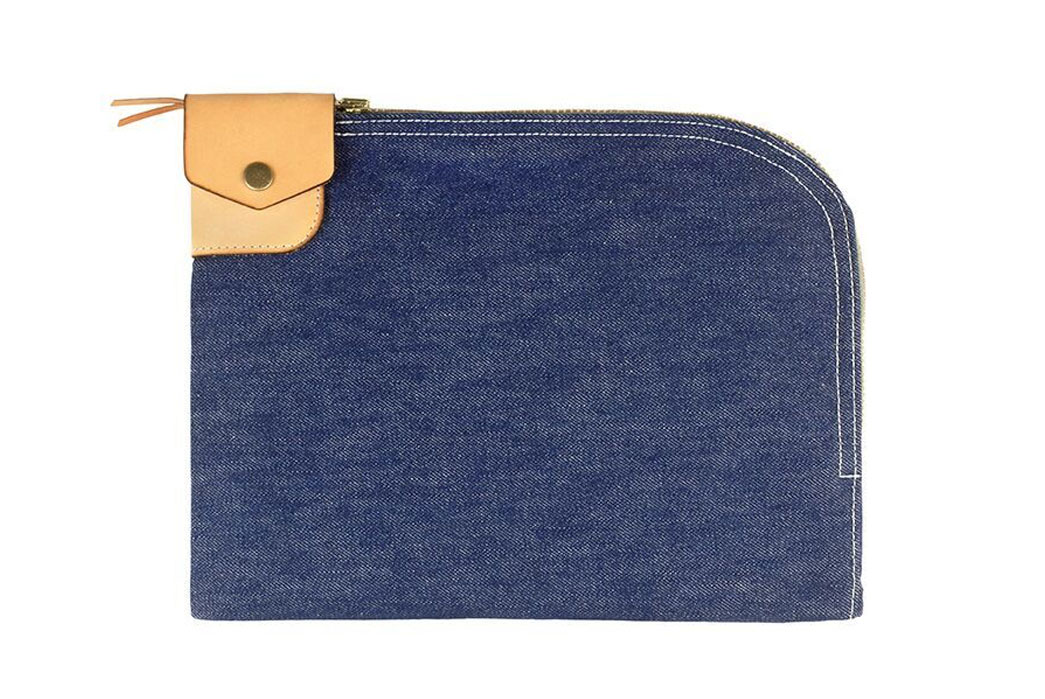
So there you have it. That’s our first CO-OP product, and it will be available for purchase on the Heddels Shop for $70 each beginning at 12pm noon EST on Monday, March 7.
